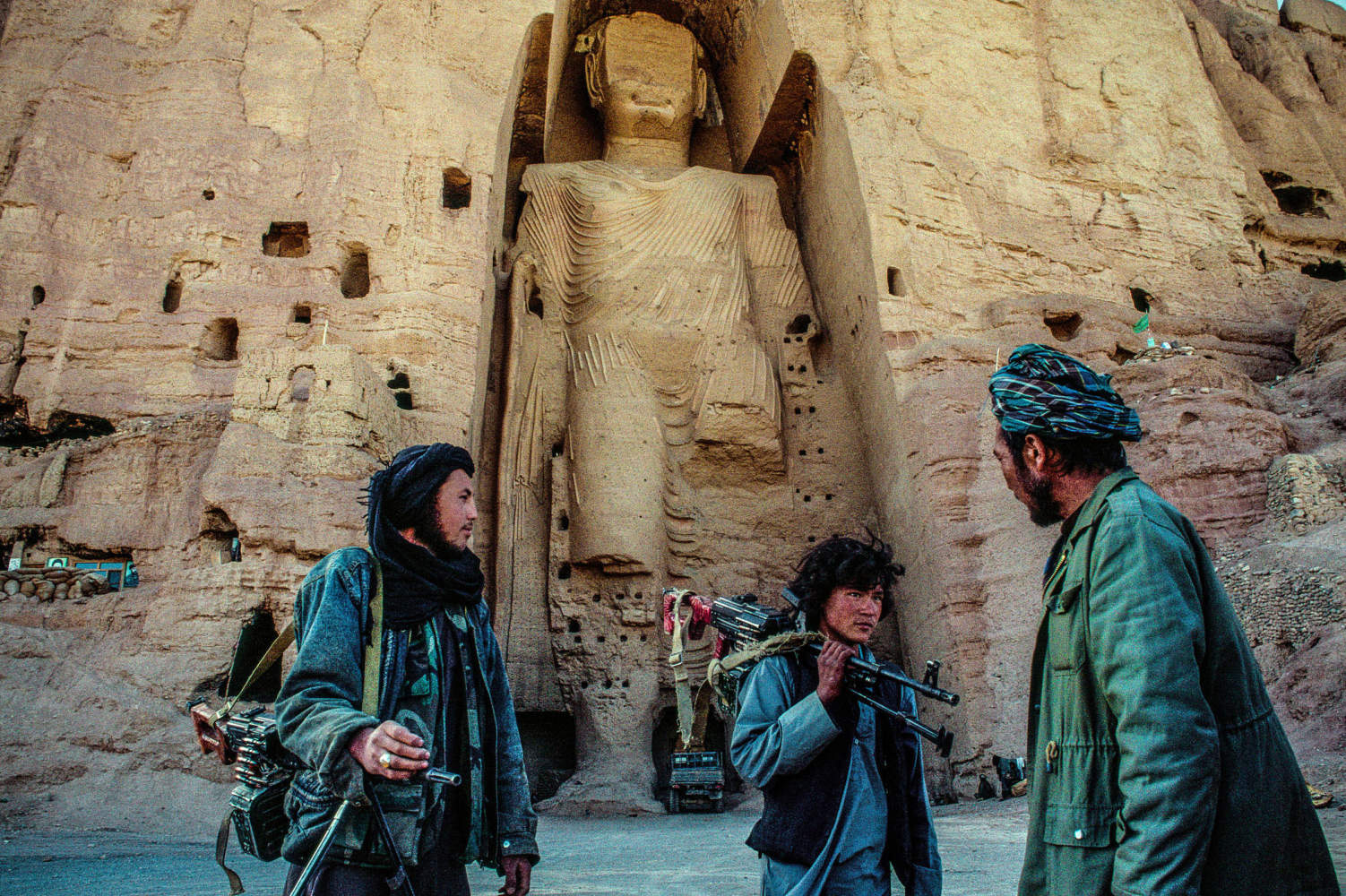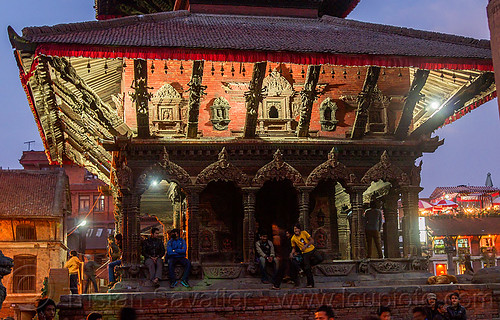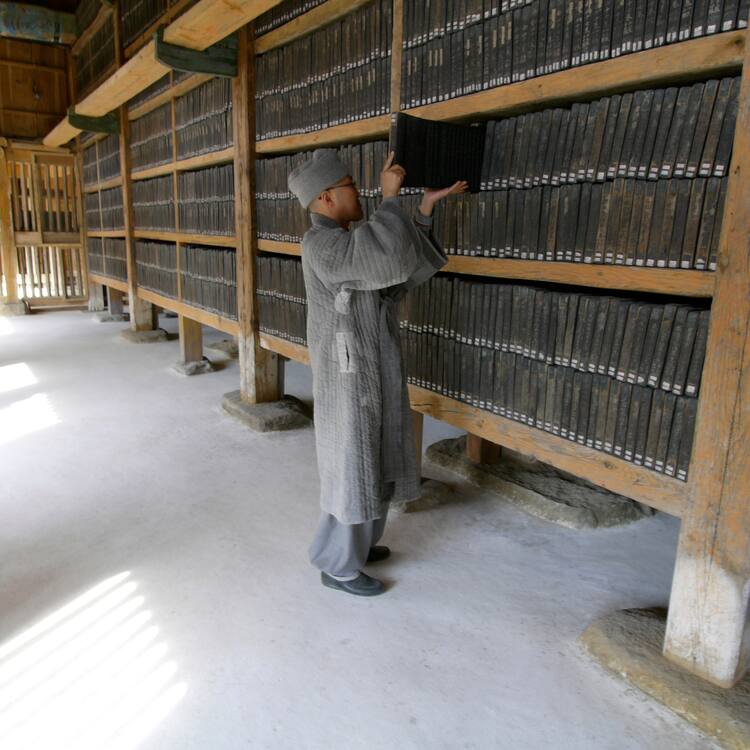By the end of my 2024 travel, I had visited every country with a Buddhist heritage. I don’t miss many Buddhist sites. This is the order in which I saw them, not any preference.
NEPAL
BOUDHANATH, Kathmandu – one of the seven Unesco Heritage Sites in the Kathmandu Valley (that count as one site). It is one of the most important Buddhist pilgrimage sites in Asia. Its origins go back to before folk memory. It has been rebuilt many times. The huge whitewashed stupa’s main dome is 120 feet in diameter and 43m high. The stupa is crowned with a four-sided all-seeing eye and a great gold tower. Prayer flags stream off everything.
We went into two of the 30-plus monasteries each with their own gigantic Buddha and listened to a group of monks chanting and playing horns and drums.
Patan’s Durbar Square, another of the seven World Heritage Sites is a spectacular collection of temples and pagodas, most made of classic wood and brick, but some of carved stone.

The concentrated mass of temples is the most visually stunning display of Newari architecture in Nepal. Building was in overdrive from the 14th to the 18th centuries. Bhimson Temple has a wild-eyed statue of Bhimson, a Pandava from Mahabharata, credited with superhuman strength.
The Golden Temple [a unique Buddhist monastery], and the five-story Kumbeshwar Temple rounded out the tour.
SWAYAMBHUNATH, Kathmandu. Mobbed by rhesus monkeys and soaring above the city on a lofty hilltop, the ‘Monkey Temple’ is a jumble of Hindu and Buddhist icons. The stupa is the crowning glory of Kathmandu architecture. On top of the huge white-washed dome representing the earth, are the four faces of Buddha staring out in the cardinal directions. The 13-tiered beehive-like structure at the top symbolizes the 13 stages man must pass through to achieve nirvana. There are prayer wheels, thousands of prayer flags and a statue garden. We listened to the morning chant in the monastery and then walked down around the base of the hill past shrines and continuous prayer wheels.
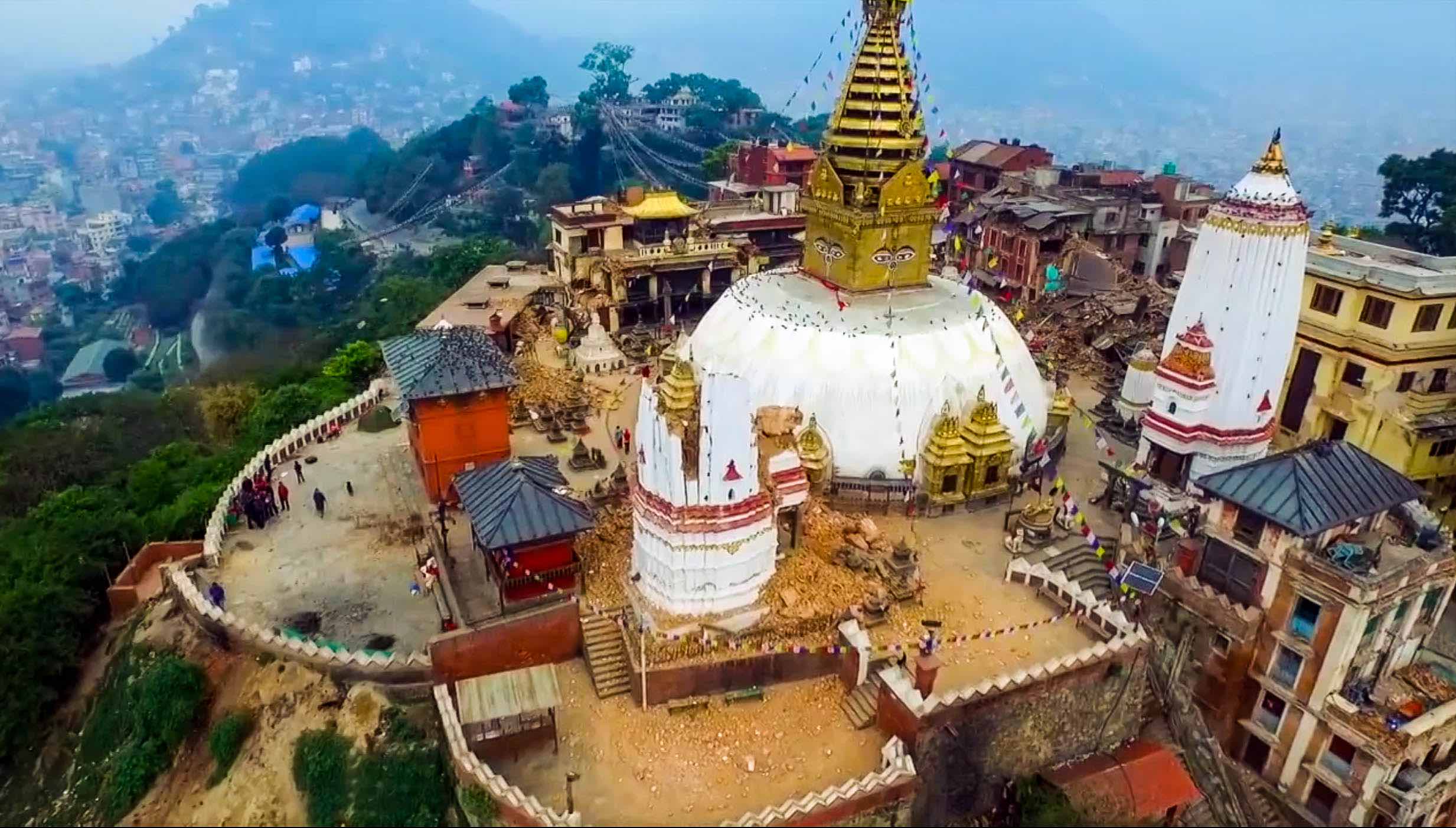
WORLD PEACE PAGODA, Pokhara. A Japanese company whose founder experienced Hiroshima and Nagasaki is building 100 World Peace Pagodas around the world and this, the 71st, was finished in 1999. It is 115′ high and 355′ in diameter with a different Buddha statue on each side.

3. LUMBINI was the birthplace of Buddha in 563 BC. World Heritage listed, it attracts pilgrims from all over the world. Initially home to hundreds of monasteries, it was abandoned by 400 AD. Since 1978, Buddhist countries have constructed extravagant monasteries spread over a huge area requiring a bicycle to see it. There are wide roads and many reflecting ponds.
The Maya Devi Temple sits on the exact site of Buddha’s birth. The temple area is reached by a long causeway across a lake that appears to surround the temple like an island. It is a plain low white brick building. One walks around a platform surrounding what looks like an archaeological dig to see the exact stone Buddha was born on through bullet-proof glass.
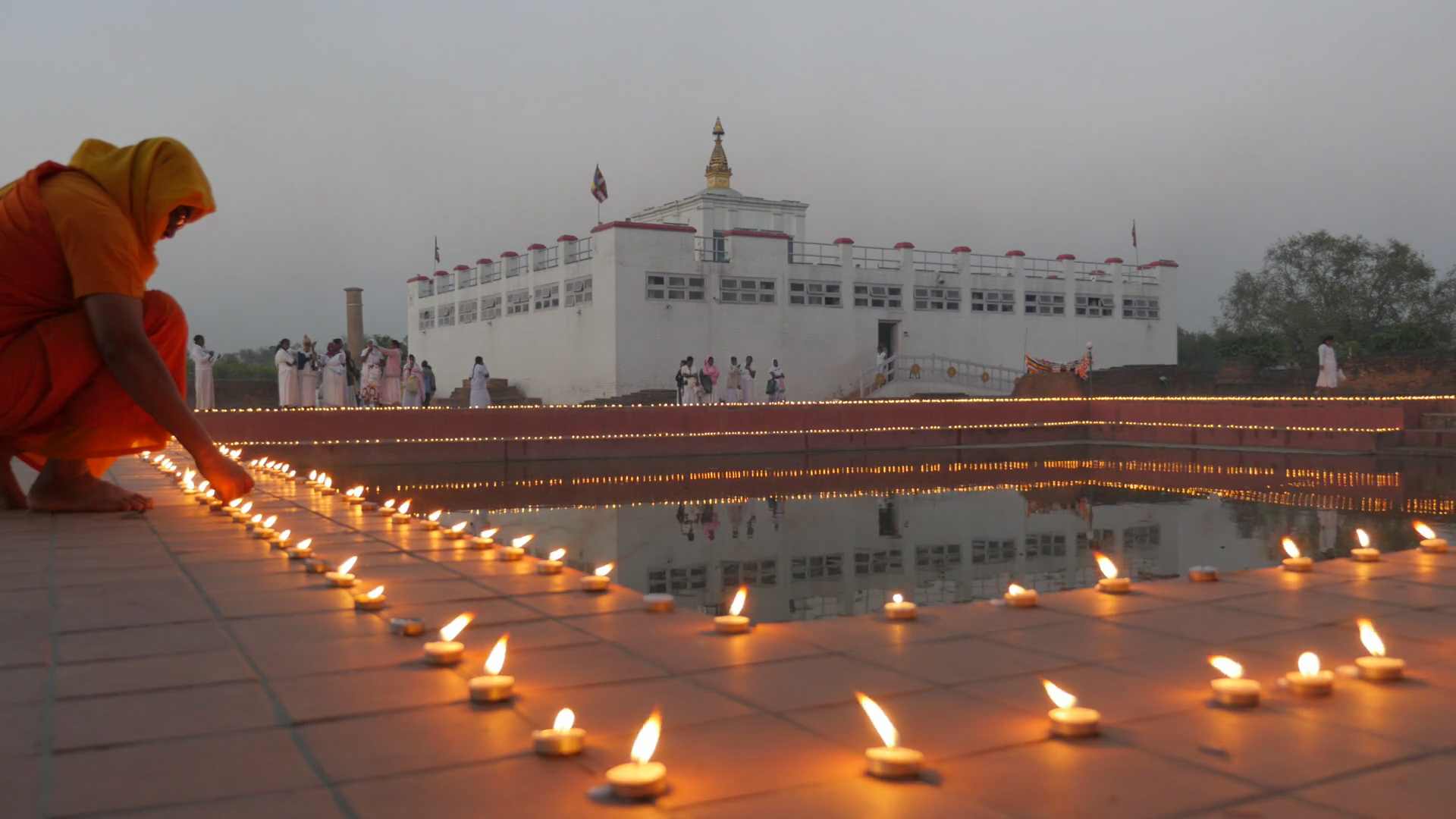
An interesting alternative is the version of Buddha propositioned by Victor of Victor’s Sculpture Garden in Ireland. Victor was a Buddhist monk for a couple of decades and I think is one of the great unsung philosophers of our time. He states that Buddha was born in Iran and never saw India.
INDIA
SARNATH, the site of Buddha’s first sermon is another of the big four Buddha sites. It is 13 km north of Varanasi. After Buddhism declined in the 7th century, it was rediscovered by the English in 1835. There is a 34m stupa, Ashoka Pillar, excavated monastery ruins, a museum (with the well-preserved, 3rd-century lion capital from the Ashoka pillar which is the national emblem of India and on all their money), and a modern temple with a cutting planted in 1931 from the original bodhi tree under which Buddha attained enlightenment (obtained from Sri Lanka).
BODHGAYA, another of the 4 great Buddha centres, is where Buddha reached enlightenment. A prince, at 29, he lived in a cave just outside Bodhgaya for 6 years without drinking water or consuming food!!! Not surprisingly he was extremely thin and was returned to health by a woman who fed him rice milk pudding. He then went and sat under the bodhi tree, attained enlightenment and became Buddha. Like Lumbini in Nepal, most Buddhist countries have built monasteries in their national style. It is a major pilgrimage site on the tourist trail with souvenir shops and all that goes with it.
Mahabodhi Temple is Unesco World Heritage listed where he attained enlightenment and formulated his philosophy of life. It was built in the 6th century AD atop a previous Buddhist temple built in the 3rd century BC by Ashoka. Destroyed in the 11th century and restored many times, the last was in 1882. Topped by an impressive 50m carved pyramidal tower, it holds a 2m high gilded seated Buddha. Behind the temple is a huge bodhi tree raised from a cutting from the original tree that somehow was growing in Sri Lanka.
Every Buddhist country has built large monasteries here as in Lumbini, all with their architectural styles, but these are all close together and easy to see. The ones I especially enjoyed were Tibet, Bhutan (amazing exterior and interior with all the walls carved in bas-relief and painted in bright colours), Japan (understated elegance) and Thailand (spectacular roof lines and a gold Buddha). The other great highlight was the 25m tall Great Buddha statue on a 10m pedestal that towers over everything. It is surrounded by 10 smaller statues of Buddha’s disciples. The statue is hollow and contains 20,000 bronze Buddhas.
Mountain Temple, just outside Bodgaya, has the cave Buddha fasted in. The statue was skeletal and the small cave was atmospheric. I came out here with a guy on a motorcycle. It was a great tour touring through the rural areas.
BUDDHA SMRITI PAR, Patna, Bihar was inaugurated by the Dalai Lama in 2010. It has a massive sandblasted charcoal stupa and a unique bulletproof chamber inside holding antiquities from several Buddhist countries.
SIKKIM
RUMTEK, Sikkim is a huge gompa (monastery) complex visible directly across the valley from Gangtok, the capital of the province. This is the home in exile for The Black Hat sect of Buddhism. The last (16th) leader of the sect died in 1993 and has not been replaced because there are two rival candidates. The Rumtek gompa is a rambling walled complex and is unusually guarded by armed police as there have been many violent altercations by monks who dispute the accession. There is a main monastery building and a Golden Stupa holding the ashes of the last leader. The Old Rumtek Gompa is a 1.5km walk away and sits in an idyllic setting on a west-facing ridge. The interior is a riot of colour.
RAVANGLA has a new giant 41m tall Buddha statue. Situated on gorgeous grounds with a hotel and meditation complex, the statue was magnificent.
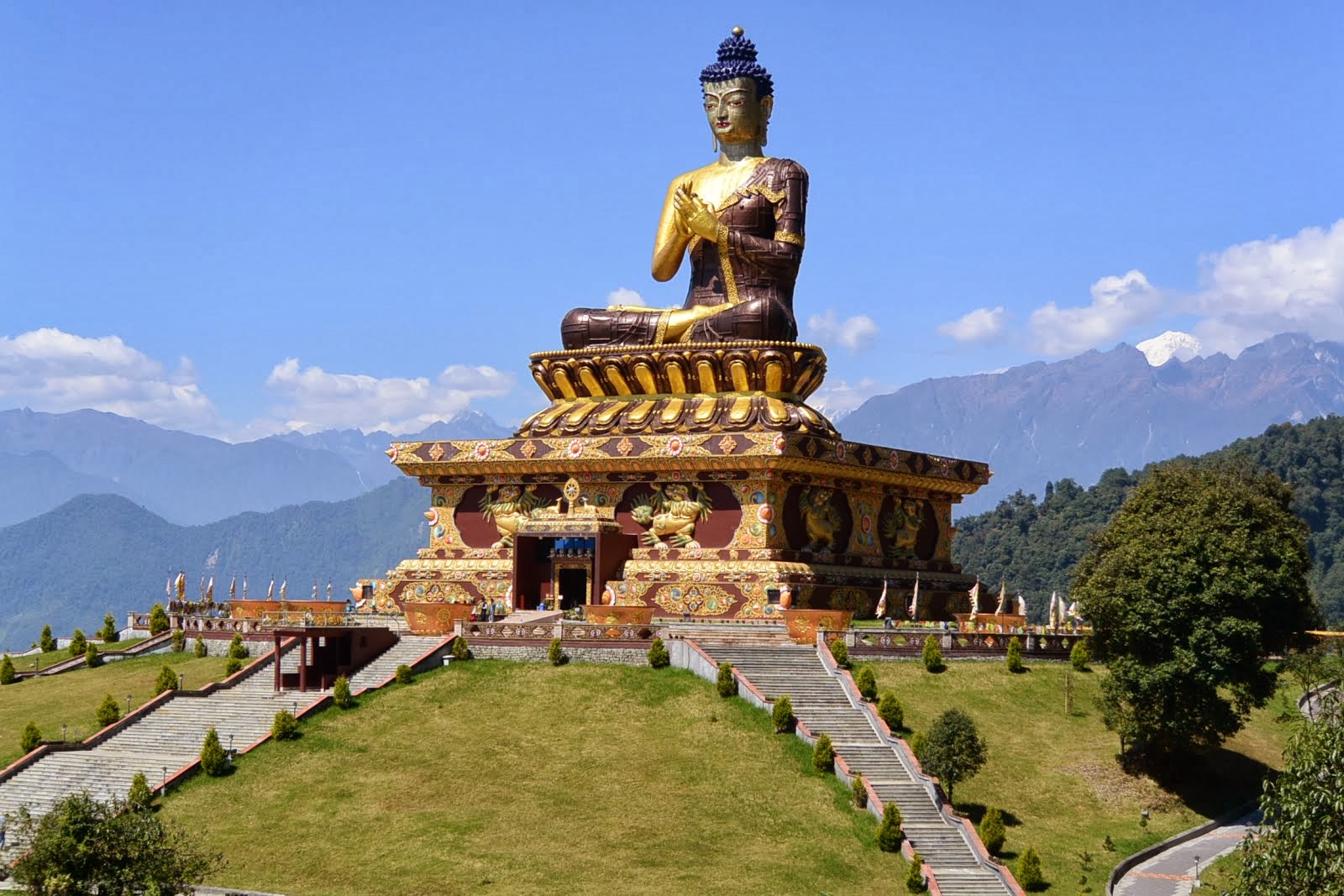
Dubdi Gompa, in Yuksom, Sikkim is the oldest monastery in Sikkim dating from 1701. It sits high on a ridge above Yuksom. There were excellent yak butter sculptures, crumbling original murals, and hundreds of Tibetan manuscripts.
Tashiding Monastery, Sikkim, sits high on an atmospheric ridge. There is a giant prayer wheel and five colourful religious buildings, all closed but one. An unusual compound contains dozens of white chortens (stupas) and engraved prayer stones with the mantra ‘mani padme hum”
NAMBHI, Sikkim has a 45m high statue of the 8th-century holy man credited with spreading Buddhism across the Himalayas with a 33m Shiva (Hindu) statue facing it across town from the opposite hillside.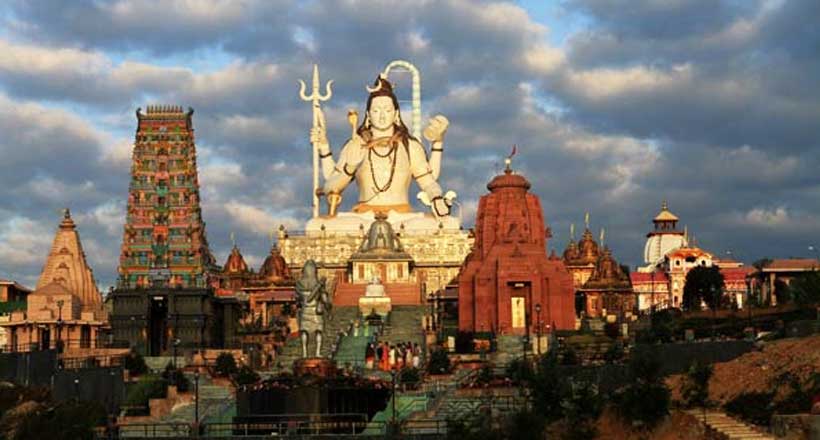
World Peace Pagoda, Bhubaneswar (like the one in Pokhara, Nepal) was built in 1972.
ELLORA CAVES is the epitome of ancient Indian rock-cut architecture. They were chipped out laboriously over 5 centuries. Used as monasteries, chapels and temples, the 34 caves along the 2 km long escarpment, are divided into 12 Buddhist (600-800 AD), 17 Hindu (600-900 AD), and 5 Jain (800-1000 AD) structures. Two Buddhist caves are outstanding – Cave 5 is 18×36 m with stone benches for use as an assembly hall, and Cave 10 has a spectacular ribbed roof and an enormous teaching Buddha.

AJANTA CAVES were built between the 2nd and 6th centuries, abandoned soon after and not discovered until 1816 by a British hunting party. The caves are best known for their renowned frescoes, still remarkably preserved today.
MCLEOD GANJ is the headquarters of the Tibetan government in exile and the residence of His Holiness the 14th Dalai Lama. The town was a backwater until 1960 when the Dalai Lama claimed asylum here following the 1951 Chinese invasion of Tibet. The Tsuglagkhang Complex is the main focus of pilgrims, monks and tourists. The temple is the exiles’ equivalent of the Jokhang Temple in Lhasa. The two temples are surrounded by the gompa where one can watch monks debate. Points of argument are sealed with a foot stomp and theatrical clap of the hands. Just inside the entry gate is the Tibet Museum telling the story of the Chinese occupation and the subsequent Tibetan exodus. The town also has many Tibetan government and cultural buildings.
SRI LANKA
Temple of the Sacred Tooth Relic, Kandy houses Sri Lanka’s most sacred Buddhist relic – a tooth of the Buddha. It was snatched from the flames of the Buddha’s funeral pyre in 483 BC and smuggled in the hair of a princess to Sri Lanka in the 4th century AD, ending up in Kandy in 1283. Stolen by the Indian army, retrieved by the Ceylonese, stolen and burnt by the Portuguese (turned out to be a fake tooth), it finally returned to Kandy and the Temple was finished in 1782. Sri Lankan Buddhists believe they must make one pilgrimage here in a lifetime to improve one’s karma and the temple is a busy place. However, one does not see the tooth. It’s kept in a gold casket shaped like a dagoba (stupa), which contains a series of six dagoba caskets of diminishing size. The stupa casket is viewed from a doorway 3m away and the queue is kept moving so one only gets a brief glimpse inside the shrine room. Behind the main shrine sits a large hall with dozens of sitting Buddhas and a series of pictures depicting the life of the tooth. Behind this whole complex is the World Buddhism Museum showing Buddhism around the world.
ADAM’S PEAK (2247m), is a lofty peak that has been a focus for pilgrimage for over 1000 years. It is named after the place where Adam first set foot on earth after being cast out of heaven or Sri Pada (Sacred Footprint, left by Buddha as he headed towards paradise). In the pilgrimage season from December to May, the 7km of cement stairs to the top are illuminated at night with refreshment stands. Most start the 2-3 hour walk around 3 am up the 5200 steps to reach the top before sunrise. You pass a World Peace Pagoda near the beginning. There is a temple at the top with a giant Buddha foot as the idol.
DAMBULLA ROYAL ROCK TEMPLES are a Unesco World Heritage Site. Carved into the face of a big cliff, the five caves contain about 150 Buddha statues dating from the first century BC to more modern times. The entire inside – walls and ceilings, are spectacularly painted with geometric designs and Buddha scenes. The colours are still vivid. Cave 1 has a 15 m-long reclining Buddha that is beautifully carved. Cave 2 is arguably the most spectacular measuring 52m long by 23m deep with a 7m high ceiling. Besides at least 50 Buddhas (the main one is under an archway decorated with dragons and has the right hand raised in pose conveying protection), there are two statues of the kings who had the cave built. Hindu deities are also represented. A vessel sits under a constant drip from the roof, even during droughts, and the water is used during rituals. Cave 3 too is filled with Buddha statues including a beautiful reclining Buddha. Cave 4’s central Buddha sits under a decorative arch and his hands are in a meditative pose in which the hands are cupped. Cave 5 features a reclining Buddha and Hindu gods. Try to come when there are no crowds, especially tour groups, whose constant chatter ruins the peaceful ambiance.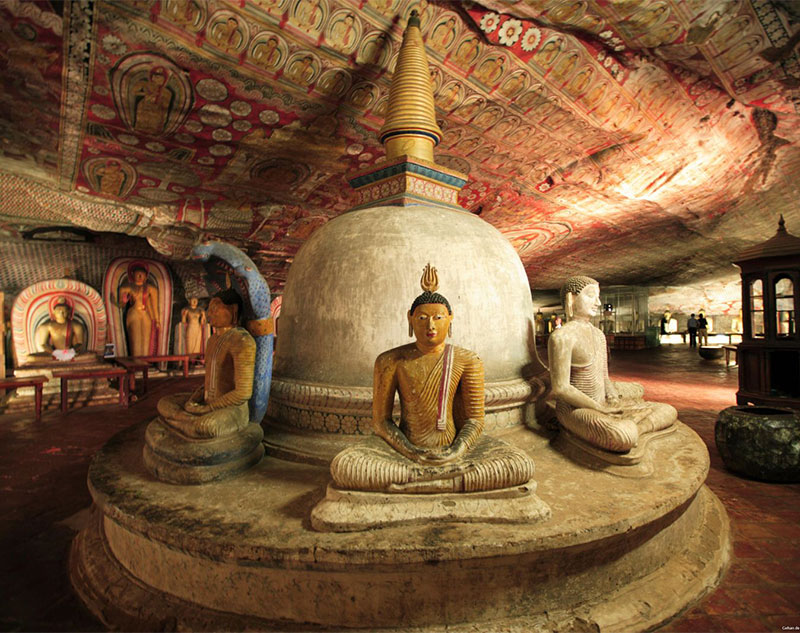
The Golden Temple is a modern, kitschy building behind the square at the bottom of the complex completed in 2000 using Japanese donations. On top of the cube-shaped building sits a 30 m-high gold-coloured Buddha in the wheel-turning pose. The Dambulla Museum is 500m south of the above complex and showcases art from prehistoric cave paintings to 18th-century frescoes.
SIGIRLYA is the premier site of the Cultural Triangle. Geologically, Sigirlya is a hardened magma plug of an extinct volcano that long ago eroded. Peppered with natural cave shelters, rock overhangs and numerous hand-hewn additions, the rock and surrounding area was developed during the reign of King Kasapa (477-495 AD) who built a royal palace on the top.
The monastery complex was abandoned in the 14th century, and ‘rediscovered’ by the British in 1898. It was declared a World Heritage Site in 1982. The theory is that the top was always a Buddhist monastery. The 370m ascent is on marble stairways and constructed metal boardwalks scaling the sheer cliff. Halfway up is a metal stairway that leads to a sheltered gallery of fresco paintings of buxom, wasp-waisted women. Protected by a big overhang, the paintings are in remarkable condition with glowing colours. All that remains today of the palaces or monastery, depending on the theory, are foundations, a carved platform, and a 27x21m square water tank.

ANURADHAPURA
SRI MAHA BODHI, Mahavihara Area. The great bodhi tree is central to Anuradhapura in both a spiritual and physical sense. The huge tree was grown from a seedling brought from Bodhgaya in India by the sister of Mahinda who introduced the Buddha’s teaching to Sri Lanka. Surprisingly, the present bodhi tree in Bodhgaya was grown from a cutting of this tree. The sacred bodhi tree is the oldest historically authenticated tree in the world: it has been tended by an uninterrupted succession of guardians for over 2000 years, even during periods of Indian occupation (the oldest trees in the world, however, are the bristlecone pines of the White Mountains of eastern California, the oldest of which are documented to be 4,600 years old).
There are several bodhi trees here, the oldest and holiest stands on the top platform surrounded by a golden railing. Thousands come to make offerings, especially in December and April. A temple stands on the east side and the whole complex is surrounded by an ancient stone wall.
The Brazen Palace ruins are close to the Bodhi tree. All that remains of this once huge palace are 1,600, ten-foot high, square stone columns of a building thought to be nine stories high and home to 1000 monks. First constructed 2000 years ago, it was rebuilt many times, the last in the 12th century. The columns stand behind a fence. Near is an abandoned monastery with a huge stone trough that could hold enough rice to feed 3000 monks.
The Ruvanvelisaya Dagoba, originally built in 140BC, and rebuilt many times, is a huge 55m high, dazzlingly white, bulbous-shaped stupa. The wall at the base has a frieze of hundreds of large elephants standing shoulder to shoulder.
Just north, the Thuparama Dagoba dates from the 3rd century BC and is the oldest in SL and maybe the world. Stupas are solid, have no entrances or interiors, and exist only for their exteriors.
The rest of the sites visited are away from the Mahavihara area and scattered next to the Tissa Wewa, a large lake. From the 2nd century BC, the Mirisavatiya Dagoba is big and white. Isurumuniya Vihara, also 2nd century, is a rock temple with a small museum containing a sculpture of the ‘lovers’. Vessagiriya is the remains of a cave monastery complex.
Jetavanarama Area. The Jetavanarama Dagoba was built in the 3rd century, and once stood over 100m high (then the 3rd highest monument in the world, the first two being the Egyptian Pyramids), but today is about 70m. It is covered in dark brown bricks – it has been calculated that there were enough bricks in the dagoba to make a 3m-high wall stretching from London to Edinburgh. Behind the dagoba is a monastery that housed 3,000 monks. One building has door jambs over 8m high still standing. At one time, massive doors opened to reveal a large Buddha image. On the other side of the road is a 42mx34m stone wall enclosure built to imitate a log wall. The building is long gone. The museum associated with this site has a carved urinal and beautiful jewelry, carvings and pottery.
Abhayagiri Monastery Area. This is spread out over a huge forest with scattered ruins everywhere. The 75m tall Abhayagiri Dagoba was created in the 1st and 2nd centuries BC and was the centrepiece of a huge monastery for 5000 monks. Chinese traveler Faxian visited in 412AD. It too is all brick and has some interesting bas-reliefs. A ruined 9th-century school for monks has the finest carved Moonstone in SL. A moonstone is a semicircular carved rock on the ground at the entrance to a building. It was decorated with carved lions, elephants, horses, and geese. The fine steps feature plump little figures. Ratnaprasada has the finest guardstones in Anuradhapura featuring a cobra being swallowed by a dragon. The Samadhi Buddha is a 4th-century seated statue in a seated pose and is regarded as one of the finest Buddha statues in SL. Kuttam Pokunaor the twin ponds are two swimming pool-like bathing tanks. Water entered through the mouth of a mythical multispecies beast, and was filtered and drained through both tanks. There is a nice five-headed cobra carving. Abhayagiri Museum has a collection of toilets, urinals, jewelry, and religious sculptures.
Citadel Area. This newer area has few remains of a Royal Palace plus an enormous trough filled with rice for the monks. The temple was the first Temple of the Tooth that originally came to Sri Lanka in 313 AD.
POLONNARUWA
The ruins are divided into 5 groups. The Archaeological Museum is excellent, but I arrived at the same time as 300 pilgrims walking from Colombo to the north of Sri Lanka. In this heat and humidity, they looked beat and very sweaty. I could understand the many monks in the group but wondered about the Westerners as they trooped in single file through the museum, too tired to look at anything. Several of them were bagged out on the floor. The ruins are spread out along a very long road, spaced in a big forest.
Royal Palace Group. The Royal Palace was big, 31x13m, and 7 stories high with the top 4 stories of wood. Now a few of the brick and rubble walls remain with little detail. The Audience Hall had a frieze of elephants, each in a different position. Two monitor lizards were fighting in a nearby mud hole.
Quadrangle Group. A Circular Relic House had an 18m diameter terrace with a central dagoba and 4 entrances flanked by fine guardstones and the best moonstones in the whole site. The Thuparama Gediga is a hollow Buddhist temple with an intact roof. The Gal Pota is a 9×1.5m, 66cm thick hunk of rock weighing 25 tons with an inscription extolling the king’s virtues. It was dragged 100km to this site. The Hatadage is a tooth relic chamber. The Satmahal Prasads consist of 7 decreasing stories shaped like a small pyramid. There are several other small buildings.
Northern Group. I was thankful for the bike as things get spread at this end of the road. One passes a few Hindu temples all with Shiva linga. Rankot Vihara is 54m high dagoba, the largest in Polonnaruwa and the 4th largest on the island. Like most other dagobas, it is an earth-filled dome covered by a brick mantle.
The Buddha Seema Prasada is the monastery abbot’s convocation hall. The Lankathilaka has 17m high walls with a collapsed roof and a huge standing headless Buddha. The Kiri Vihara is a medium-sized dagoba whose overgrown jungle was cleared away after 700 years of neglect. The original lime plaster was in perfect condition, and it is the best-preserved dagoba in the entire site.
I saved the best for last, as the Gal Vihara is a group of beautiful Buddha statues that mark the high point of Sinhalese rock carving. There are four statues all cut from the same piece of cream-colored granite with dark grey streaking. All are in perfect condition. The standing Buddha is 7m tall and has unusually crossed arms and a sorrowful facial expression. The 14 m-long reclining Buddha has a subtle depression in the pillow under his head and a wonderful wheel symbol on the pillow end. The other two statues are seated Buddhas. One is surrounded by a background of carved temples and an arch. These are the highlights of Polonnaruwa. There are two other small groups of buildings I did not bother with.
BHUTAN
Tango University of Buddhism. In 1619, Zhabdrung Ngawang Namgyal came to Bhutan. Called the architect, he was responsible for building most of the monasteries and dzhongs (fortresses) still standing in Bhutan today. He built this monastery in 1620 as an institute for monks. It has the same function today and monks commit 3 years, 3 months and 3 days to study. The 45-minute walk up to the monastery is through an oak forest. Buddhist sayings pepper the trail. Gorgeous langur monkeys with black faces, white heads and chests, a grey body and long prehensile tails were scrambling and fighting in the trees. On the drive here, we had passed a stream with several small “houses” perched over it. I was impressed with what appeared to be a run-of-the-river hydroelectric project. However, the only things being turned were prayer wheels. The courtyard of the Astrology Monastery had two enormous cypress trees, now rarely seen in nature. A virtual look-alike to our western red cedar, these were as big as our largest. I counted 17 dogs snoozing, preparing for their night of mayhem.
The Thimphu Zoo holds a few deer and the takin, the national animal. Several years ago, the king decreed that it was improper for a Buddhist nation to keep an animal in captivity. The animals were set free and the zoo closed, but the takin refused to leave the area. They were soon roaming the streets of town. The present minimalist preserve was then built. The takin is unrelated to any other animal and has an unusual appearance – the head of a goat and the body of a cow.
The National Memorial Chorten memorializes the third king, the father of modern Bhutan. Carrying the message of world peace and prosperity, it has a classical stupa shape, but with rooms inside, wall paintings and statues. Many elderly were sitting with their prayer beads or circumnavigating the stupa.
BUDDHA POINT, at 167′ tall, is the tallest sitting Buddha in the world. It sits high above Thimphu giving panoramic views of the valley and city. Made of bronze and studded with semi-precious stones, Bhutan cannot cast the large pieces. They were manufactured in China and then assembled here. A temple was built in the base but the large plaza in front was still under construction in 2013.

PUNAKHA VALLEY
The Divine Mad Man’s Temple was built in 1499 on a hillock in the center of the valley. He used humour, songs, and sometimes bizarre and shocking behaviour with deep sexual overtones to dramatize his teachings. The temple has several wooden phalluses brought from Tibet by the lama. Penises complete with testicles are painted on most commercial buildings and carved phalluses are for sale everywhere. One store is called Phallus Handicrafts. Pilgrims receive a blessing to ward off evil by being struck on the head with a ten-inch wooden phallus. It is believed that childless couples that pray here will be blessed with children and women visiting from all over the world. This is the only temple where alcohol is seen on altars – the Divine Madman liked his booze. The temple is accessed by a lovely 20-minute walk across rice paddies. Small groups of teenage monks were practicing playing the musical instruments that are part of Buddhist rituals.
THE PUNAKHA DZHONG was built in 1638 by the architect at the confluence of the Mo Chuu and Po Chhu Rivers at the exact spot prophesied by the founder of Bhutanese Buddhism, Guru Rinpoche, 800 years previously. It is easily the most impressive building and dzhong in Bhutan. Tall white stone walls enclose two huge rectangular towers. One showcases all of Bhutan’s art forms. Elaborate worked gold metal surrounds the many columns. Intricate paintings of the story of Buddha cover every wall and embroidered cloth hangings adorn everything. I watched a monk do a butter sculpture. With 8 mounds of differently coloured butter, he applied it using his thumb to construct intricate flowers. This dzhong served as the capital of Bhutan until 1955 and is still the winter residence of the central monastic body, the ruling organization of the Drukpa Kagyu School of Buddhism.

Khamsum Yulley Namhyal Chorten or “Queens Chorten”. It took 9 years to build and was finished in 2004 by the mother of the present king. Sitting high above the valley, there are commanding views in all directions. The temple is considered one of the finest examples of the use of traditional Bhutanese architectural style in modern times. The inside has 4 levels adorned in the best architectural style. It is impossible to describe the wood carving and fantastically painted interiors. Each has statues of all the important people in Bhutan’s Buddhist culture – Guru Rinpoche, the Architect and the pantheon of Buddhist gods. Every altar has bowls of holy water filled before sunrise and emptied after sunset daily. Lotus blossoms float in the water. Butter lanterns give a musky scent to the air. Donations of food and money compete with butter sculptures and candle-driven prayer wheels. Ancient elephant tusks flank the altar. On the roof, we enjoyed the stupendous views.
Talo, the hometown of the present queen has an 8-foot wide road paved since her marriage, we visited an ancient monastery with all the usual over-the-top interiors. Here the 400-year-old paintings were directly on the concrete but in good condition. Four young monks were playing darts and they let me join them. It took several attempts to get my range (50m is a long throw), but I still never got very close. On the way down, we visited a nunnery, one of three in the country. Small groups of tonsured women sat on the grass practicing their prayers and chants. They were a much more serious group than any male monks. The monastery was as fantastic as all the others. An imposing statue of Chenrizig, the 11-headed, thousand-armed god of compassion, was the main deity. Anybody who says Buddhism is a philosophy, not a religion, has not seen this religion in action.
TIGERS NEST is the iconic and most famous Bhutan tourist site. It has been listed as one of the ten holiest places in the world. It is called the Tigers Nest as Guru Rimpoche is said to have flown to the site on the back of a tigress and the monastery was built in 1692. Fire damaged the monasteries in 1951 and 1998, after which a major reconstruction was undertaken. After a 30-minute drive north of Paro, we joined the throngs starting the hike. Horses are available for rent. Supposedly a 900m elevation gain, it is probably more like 600m. It took me 1 1/2 hours at my slow steady pace, and I lost count after passing the 100th person. This was a physical test for most. Prayer flags are everywhere in Bhutan, but the numbers here were over the top. Some spanned impossible distances. The high point of the trail is reached at a viewpoint – both the valley below and the monastery perched on a ledge on a vertical granite wall. There are at least 10 other monasteries dotted across the cliff above the one at Tigers Nest. The location is spectacular. One descends many steps built on the cliff to the base of a stunning waterfall, and then a tiring ascent to the monastery. I was frisked for the first time in Bhutan. The monastery is a series of seven or so small temples, each with its gods and statues. I had beaten all the people and was alone in most of them. I wandered through them for over 50 minutes and then the crowds arrived.
Jowo Temple of Kyichu is the oldest existing temple in Bhutan built in the 7th century. Besides ancient relics, the painted walls were obscured by the soot of butter lamps. Hundreds of prayer wheels fill niches in the exterior walls.
Chele La Pass (at 3980m, the highest road pass in Bhutan) to the Haa Valley (2700m). The narrow but good road switchbacked up through a wonderful forest of large mature spruce, fir and larch to the pass. We had good views of the Himalayas including the highest mountain in Bhutan. There are 2 temples, the Black and the White Monasteries, both very old.
MYANMAR
The Myanmar style of Buddhism is unique. Large stone lions flank the large stairways leading up to a raised platform on which the gold stupa sits. The stairways are usually lined with vendors. Temples line the outer walls of the platform, usually with many Buddha images. Altars are simple with flowers, holy water and sometimes fruit. Flashing neon lights are behind Buddha’s head. There is no pantheon of gods – only one, Buddha. The interiors of the temples are simple often painted gold. Dioramas with statues of monks or disciples are frequent. The roof lines, however, are ornate with multiple tiers and goldcrests. Most stupas have corners for the eight days of the week. The stupas are always painted gold and have ornate metal cones on top. There are no entrances into the stupa proper – they are solid. People walk clockwise or counterclockwise, it doesn’t seem to matter. There are no prayer wheels or prayer flags. Just as everywhere else, people pray with prayer beads of 108 beads and keep up a droning chant.
Male monks wear maroon and the frequent nuns wear pink. They enter the monastery as little children, often from families with too many children to support. Up at five, they make the rounds of the village or city with their large bowls, begging for food from the members of the town. They do not eat after noon. They seem very worldly – have smartphones, ride in taxis and shop in stores. The internet cafe I used in Mandalay always had at least 10 teenage monks using Skype, and Gmail, and playing video games. They receive a normal education and sometimes college degrees and Ph.D.s. Foreign teachers said they were normal, mischievous boys but also keen students.
SULE PAYA is a 2,000-year-old Buddhist temple occupying the largest traffic circle in Yangon – the ‘gold’ stupa is a landmark. The Myanmar style of Buddhist architecture (like most countries) is unique with plain interiors and a heavy emphasis on gilding. All the Buddha’s heads are surrounded by flashing neon.
SHWEDAGON PAYA is Yangon’s defining image, and a symbol of Burmese identity for 2,500 years. The compound with its main zedi (stupa) and 82 other buildings is astounding any time of the day, but evening and sunrise, when the light hits the gilding are the best times to visit.
Paya means ‘Holy one” or religious monument. Shwedagon is said to be built on a hill where Buddha relics have been enshrined, including eight hairs of Buddha. The zedi is 98m tall and over the years has accumulated 53 metric tons of gold leaf. The top of the spire is encrusted with over 5000 diamonds and 2000 other stones.
We went in the evening by taxi for 2000 kyat. Though there are elevators, I would encourage you to walk up one of the huge, graceful stairways (one for each direction). The stupa is surrounded by eight ‘corners’, one for each day of the week plus one extra. Using the day of the week they were born, one pours cups of holy water over a Buddha image, one for each year of their age plus one extra. One could spend 3 hours exploring all the temples, large bells, several gigantic bodhi trees, and Jade Buddha, or simply sitting around soaking in the ambiance./shwedagon-pagoda-yangon-5a0e73e44e4f7d0036a76931.jpg)
Manhangar Pagoda, Inle was originally built in 1313. Five sacred mounds of accumulated gold leaf covering ancient Buddha images are worshipped. As in all Buddhist shrines in Myanmar, women are not allowed up on the altars.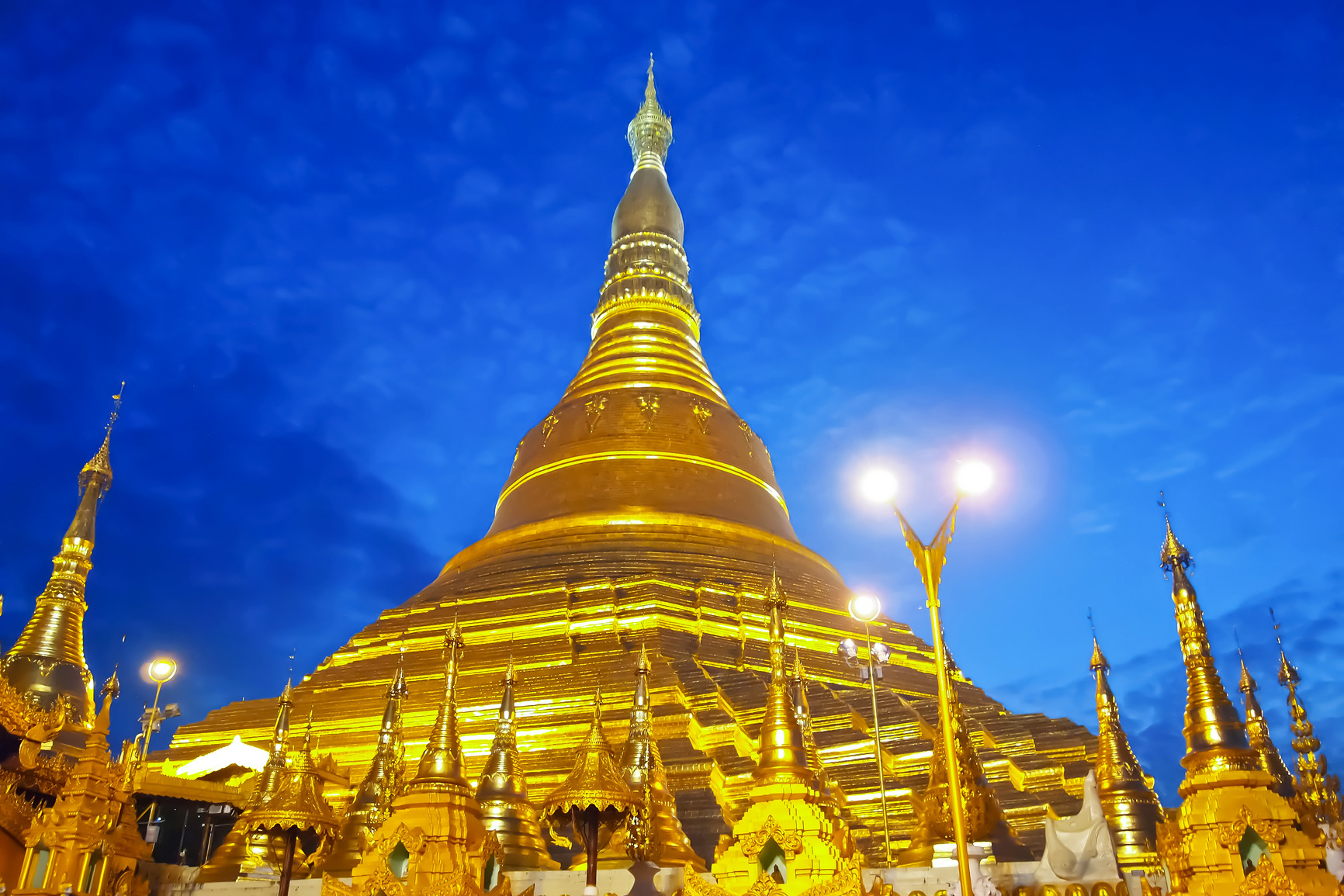
Shive Inn Dain Pagoda. We took a long, narrow river trip at the end of the lake. Walking along a river with a big weir, you end up climbing up a big covered stair to the top with a large temple, surrounded, at last count, by 1,054 stupas. The original stupa built in 270 BC is encased in the present pagoda. The oldest stupas are crumbling brick but many are modern and all sizes.
MANDALAY
Mahamuni Paya is a temple with a 4m-tall Buddha image seized from Rakhine State in 1784. Cast as early as the first century, its story of transportation by boat and land is told by wonderful paintings in one of the rooms. It is so venerated that it is washed and its teeth brushed every morning at 4 am by a team of monks (many tourists attend). It is now covered by 15cm of gold leaf, applied by hundreds every day. The upper part of the statue can’t be reached to apply gold but the arms have disappeared under it. Women are not allowed on the platform. In the NW corner of the compound is a room holding several large bronze statues originally from Angkor Wat in Cambodia, taken as booty from a war with Thailand, lost and then recaptured again in 1599. One is a three-headed elephant, there are two 8-foot-tall warriors and two lions. Legend has it that touching parts of the statues that you may be having health problems with, will cure you. As a result, the patina is well-worn and holes have formed in noses and other parts.
Sagaing is the ancient capital of the Sagaing Dynasty (1315-1364). There are 500 stupas and monasteries covering the hilltops above the river. After a 30-minute climb, I reached the top of Sagaing Hill and the monastery with outstanding views of Mandalay, the river and all the surroundings. Gold stupas poke above the trees everywhere.
Mingun is home to a trio of unique pagodas. We reached it north of Sagaing in a half hour. The Mingun Payais are the remains of a planned 150m tall stupa, a candidate for the world’s largest pile of bricks (thought to be a billion as the huge structure is entirely brick with no earth fill). Before an earthquake on 11/11/2011, it was possible to climb to the top. The Mingun Bell holds the record for the world’s largest uncracked bell (one-third the size of a bell in Moscow and 14x the size of the bell in St Paul’s Cathedral). Casted in 1865, it weighs 90 tons and is 16.3 feet wide at the bottom and 12 feet high. 200m north is the white, wavy terraced Hsinbyume Paya. The remnants of two huge lions are across the street from the Paya. The heads are gone and the backs collapsed but the rear ends with ornate plaster covering the brick remain.
Inwa, Founded in 1354, was the historical capital for four centuries. Most visitors here rent a horse and cart to make the three-hour tour of all the ruins. Several small stupas dot the roadsides; one has an old Buddha image. The finest site is an enormous 1834 teak monastery.
Three Temples. Rarely seen by tourists, the site consists of three similar 40-meter square solid brick structures built in the 13th century, each with four arched entrances leading to a room with large sitting Buddha images. The images are unusual in that they have closed eyes and downcast heads. Some faint remnants of murals remain and the images have original paint. The most northerly two temples are in significant disrepair, but the other has been restored. Passageways connect the four rooms and stairways lead to the roof overgrown with trees. This is a good side trip on the way to the Mandalay airport.
BHAMO has the usual stupa and the Thousand Monks, a single file line of monk statues, each slightly shorter and with different features than the one before, following a large Buddha image.
BAGAN The Bagan Archaeological Zone stretches for 41 sq. km. Despite centuries of looting, neglect, erosion, earthquakes and dodgy restoration, the temple-studded plain remains impressive. In a 230-year building frenzy ending in 1287 and the Mongol invasions, Bagan’s kings commissioned over 4000 Buddhist temples. Many restoration projects have resulted in a compromised archaeological site that can barely be described as ruined. It has attained Unesco World Heritage status since my visit, It remains a wonder. The best temples give a sense of what the place was like at its zenith, while others conceal colourful murals and hidden stairways that lead to exterior platforms and jaw-dropping views across the plain.
We rented bicycles and visited many small temples lining the river and the walled city of Old Bagan. On the North Plain, Ananda Pahto, built in 1105, is probably Bagan’s top draw. Here and in many other temples, the murals retain their bright colours. Shwesandaw Paya is a steep white pyramid with 360-degree views of all the temples and was packed for sunset. Several temples have interior interconnecting passageways and steep, narrow stairways taking you onto the roofs. There are so many similar structures that it gets a little redundant.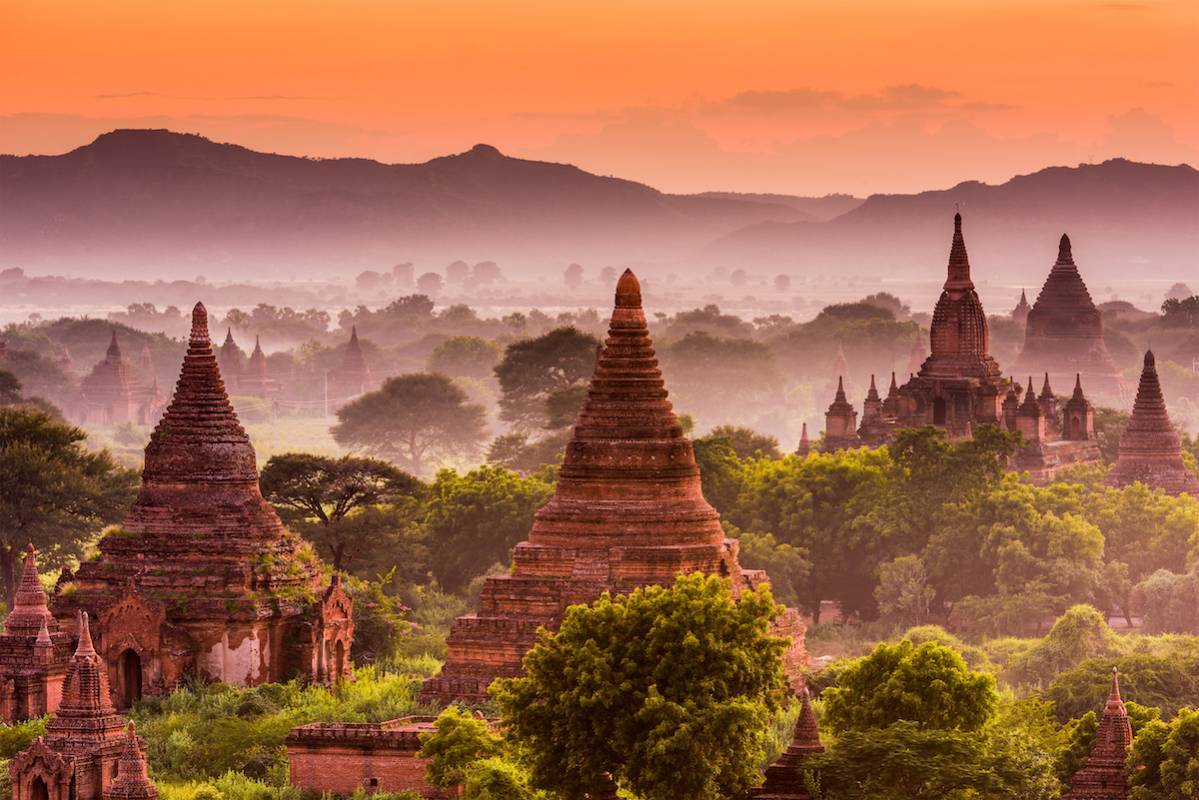
GOLDEN ROCK. This giant, gold-leaf-covered boulder appears to be hanging precariously, but the small metal stupa on top (supposedly contains a Buddha hair donated by a hermit in the 11th century. The hair was salvaged from the bottom of the sea and brought here by boat!!! and lots of gold leaf applied to the back are tipping the balance to ensure it stays where it is, despite several earthquakes. Pilgrims come here in the thousands.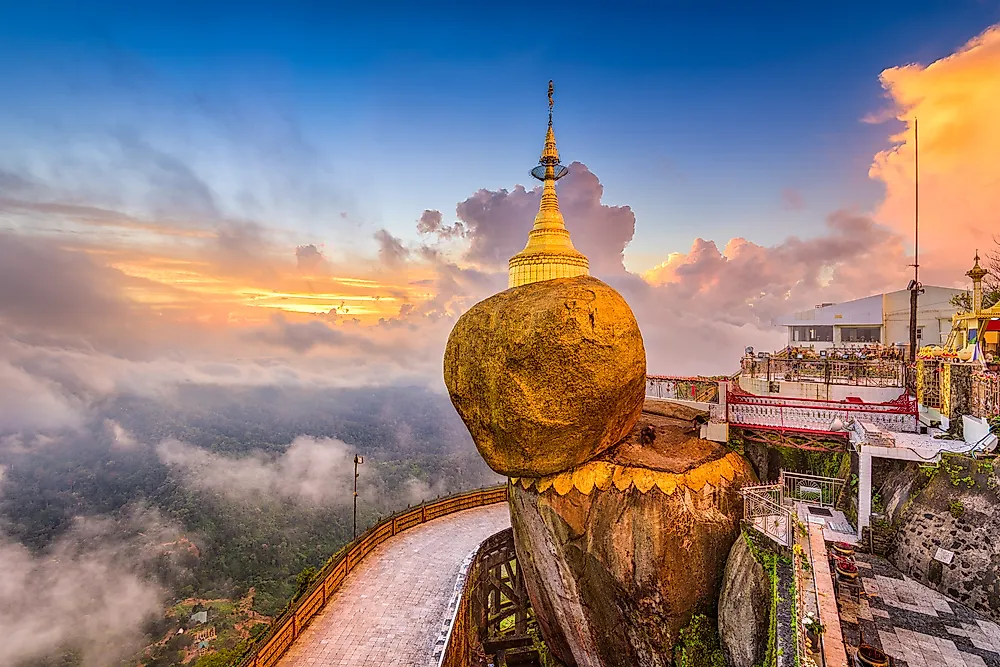
BAGO has a 55m long lying Buddha (9m larger than the one at Wat Pho in Bangkok). The soles of each foot are decorated with 108 marks representing the three worlds – 59 of the inanimate world, 21 of the animate world and 28 of the conditional world. There are two stupas (one 14m taller than Shwedagon Paya in Yangon) and several other temples. Big is better in Buddhism.


THAILAND
BANGKOK
Wat Phra Kaew, Bangkok or the Temple of the Emerald Buddha, is an architectural wonder of gleaming gilded stupas, coloured roof tiles, mosaic-encrusted pillars and marble. The revered Emerald Buddha is actually made of jasper and was once hidden under a layer of stucco in northern Thailand, seized by Laos forces and then returned to Bangkok. The temple walls are lined with colourful murals detailing the story. The Grand Palace, once the home of the Thai Royal family, is on the same grounds. The interiors of the four buildings are closed but the extravagant exterior is a riot of colored glass and mirror mosaics. The dress code is rigorously enforced – no shorts, sleeveless tops, holes in the knees, or tights, but longhis are available.

Wat Pho is the oldest and largest temple in Bangkok, dating from the 16th century. It houses the country’s largest lying Buddha, 46m long and 15m high and covered in gold leaf, signifying the passing of Buddha into final nirvana. Surrounding it are temples with the largest number of Buddha images in the country.
Wat Traimit in Chinatown shelters a 3m tall, 5.5-ton solid gold Buddha image. Cast 700 years ago, it was covered in plaster for centuries and discovered accidentally in 1954. A magnificent building has been recently constructed to house it.
Wat Arun is covered with porcelain tiles left behind by Chinese merchant ships no longer needing them as ballast.
AYUTHAYA was the capital of Thailand from 1350 to 1767 when it was sacked by the Burmese. It was built at the confluence of three rivers forming both a natural barrier to invasion and an invitation to trade. Today the ruins are spread around a modern provincial town. A Unesco World Heritage Site, the ruins on the “island” consist of many brick stupas and a few major sites.
Wat Phra Si Sanphet was the site of the royal palace, consisting of three large stupas, surrounded by a maze of adjoining buildings and small stupas, many crumbling and leaning at odd angles.
Wihaan Phra Mongkhon Bophit houses a huge bronze seated Buddha, damaged over the years by lightning and the roof falling in on it.
Wat Phra Mahathat besides the large prang (a towering phallic spire of Khmer origin serving the same function as a stupa), is one of the most iconic images in Ayuthaya, a Buddha’s head engulfed by tentacle-like tree roots.
Outside the island, I visited a recreated floating market, set at the edge of a temple, odd with its combined Hindu and Buddhist images and cement figures and gardens.
Wat Chai Wattanaram is easily the prettiest and most photogenic temple in Ayuthaya. Built in 1630, its large central prang is surrounded by 8 large stupas, brick walls and many Buddha images. Mostly intact, the brick inner structures still have large remnants of decorative stucco.
Wat Phanan Choeng contains a 19m high bronze sitting Buddha, which reportedly wept when the Burmese sacked Ayuthaya. This very holy site is always crowded with pilgrims.

OLD SUKHOTHAI is a Unesco World Heritage Site and has been described as a mini version of Angkor Wat in Cambodia. Sukhothai emerged as the Khmer empire was crumbling in the 13th century, and subsequently ruled over parts of the empire’s western frontier for 150 years. The kingdom took artistic inspiration from its former overseers building a city of temples with gravity-warped basalt columns, prangs, stupas, serene Buddha figures and weed-sprouting towers. Although Ayuthaya has a more interesting historical narrative, Sukhothai’s ancient city is better preserved and architecturally more engaging.
The central area comprises most of the ancient kingdom and is surrounded by three concentric ramparts and two moats, bridged by four gateways – important celestial geometry. Inside the old walls are the remains of 21 well-preserved historical buildings. Outside in the northern zone is an impressive 15m-high brick and stucco seated Buddha with elegant, tapered fingers. In the western zone are many relatively featureless ruins but a 12.5m high standing Buddha on the crest of a hill with good views. The layout amidst ponds, lakes and old trees took most of the day to explore.
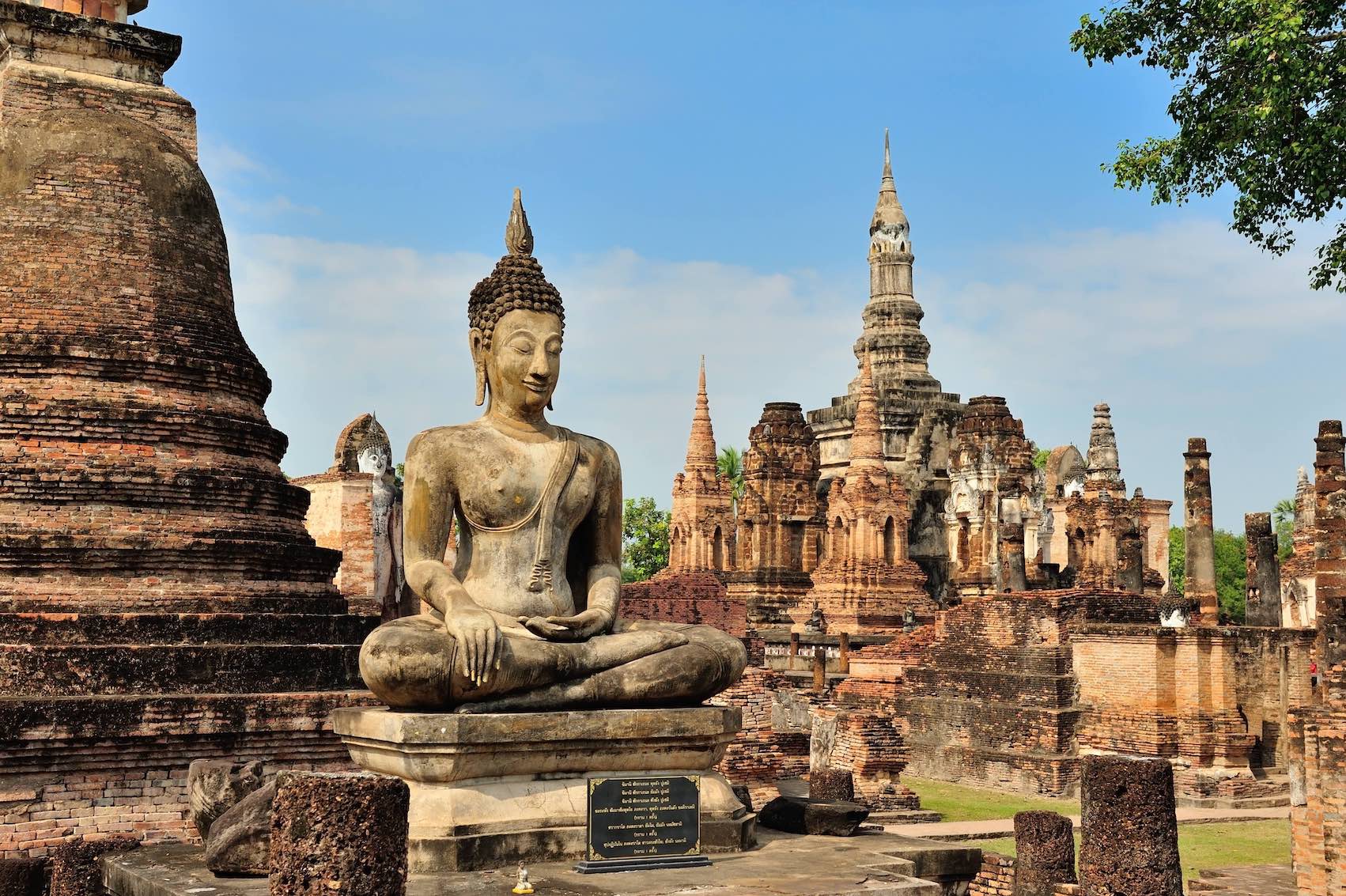
Chiang Mai Wats (temples) in the Old City. Dragons with long tails flank all entrances and form the gables of the roofs. Several were built in the 13th and 14th centuries and contain a variety of unique Buddha images.
WHITE TEMPLE, Chiang Rai is not to be missed. Construction started in 1997 and continues today under the guidance of a Thai artist who made pockets of money in the USA. White with embedded mirrors, the exterior is a riot of intricate carving. Surrounded by a small moat, one first crosses hell with hundreds of arms extending up through the water. The inside of the temples is intricately painted with modern scenes depicting many pop icons. The eyes of the image opposite the Buddha image depicted evil with George W Bush and Osama bin Ladin forming the pupils. All Thai temples have gold stupas but here only the toilets were gold.

Teak Temple, Golden Triangle is an ancient prang/stupa in a forest of teak trees.
LAOS
LUANG PRABANG is a Unesco World Heritage Site with a mix of 33 Buddhist temples and colonial architecture.
Wat Xieng Thong is the jewel of the temples. Built in 1560, the chapel has low sweeping roofs and richly decorated wood columns. The highlight is a tree-of-life mosaic on the rear wall. Surrounding buildings are covered with lovely glass mosaics depicting animals, boats, people and village scenes, something that is typically Lao.

Pho Si Hill this one hundred meter high hill has a temple on the summit and 360-degree views. A cave shrine, Buddha’s footprint and many Buddha images line the alternate path down. Several teenage monks were fun to talk to with their good English. Novices till age 20, many enter the monastery at age 9 or 10, often as the only way to obtain an excellent free education. Streams of monks walk the streets around 6 am as the village feeds them.
Pak Ou Caves are 35 km upriver from Luang Prabang on the Mekong. These two limestone caves contain hundreds of Buddha images. The upstream trip took about 2 hours.
VIENTIANE
Buddha Park. Located 25 km outside Vientiane, it was built in 1958 by a yogi-priest-shaman, who merged Hindu and Buddhist images into a bizarre but creative bunch of statues. One of the most unusual structures is a huge round building with three interior floors each with many images and a mammoth tree coming out of the top.
|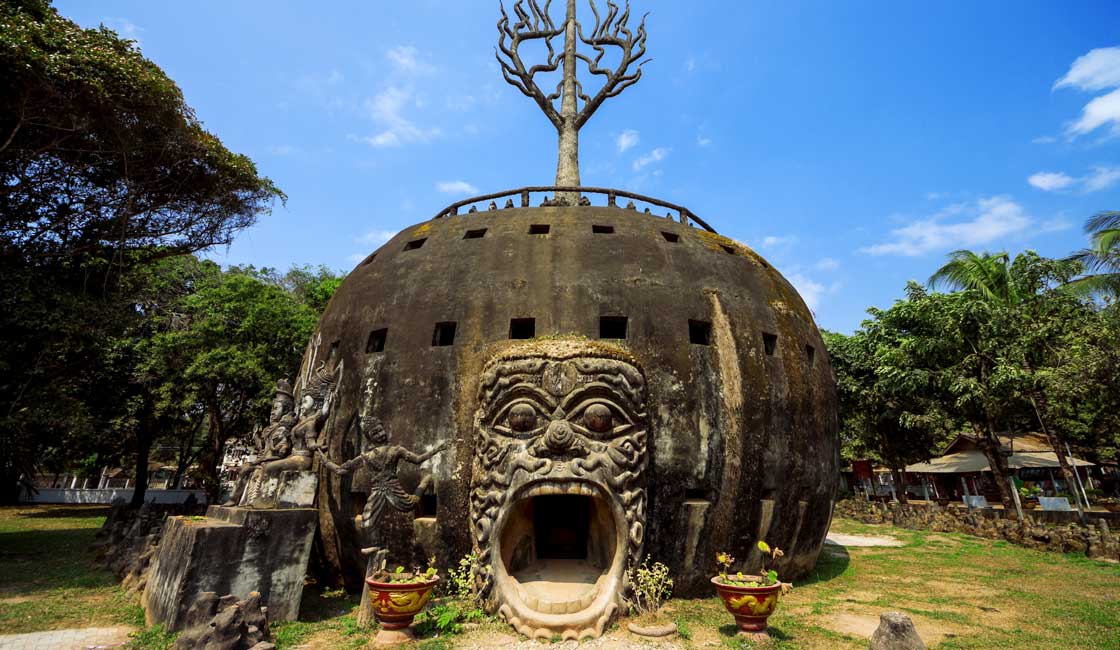
Pha That Luang is another large gold stupa and several surrounding temples.
Haw Pha Kaew is a royal temple originally built to house the famed Emerald Buddha but is now used as a national museum of religious art. It has massive ornately carved stone columns and the best collection of Buddhist images in Laos.
CAMBODIA
ANGHOR WAT the world’s largest religious building, is the centrepiece of any visit here. it is heaven on earth, the symbolic representation of Mt Meru, the abode of Hindu gods. The walls inside and out are covered with bas-reliefs and carvings. Nearly 2000 apsara or female divinity carvings and Hindu mythology scenes adorn the interior walls. But it is the exterior of the lower level that displays the most extraordinary bas-reliefs, depicting scenes and characters from Hindu mythology and the historical wars of Suryavaman II who built the temple to honour the Hindu god Vishnu: the mythological battle of Kuru on the west wall, the historical march of the army of Surryavaman II against the Cham (Vietnamese), scenes from heaven and hell on the south wall, and then the classic ‘Churning of the Ocean Milk’ on the east wall.
The inside of the temple has five towers rising 31m above the third level, the central one contains four Buddha images each facing a cardinal direction. it is open and climbed by one steep stairway. Though constructed as a Hindu temple, Cambodia has been Buddhist for almost 700 years.
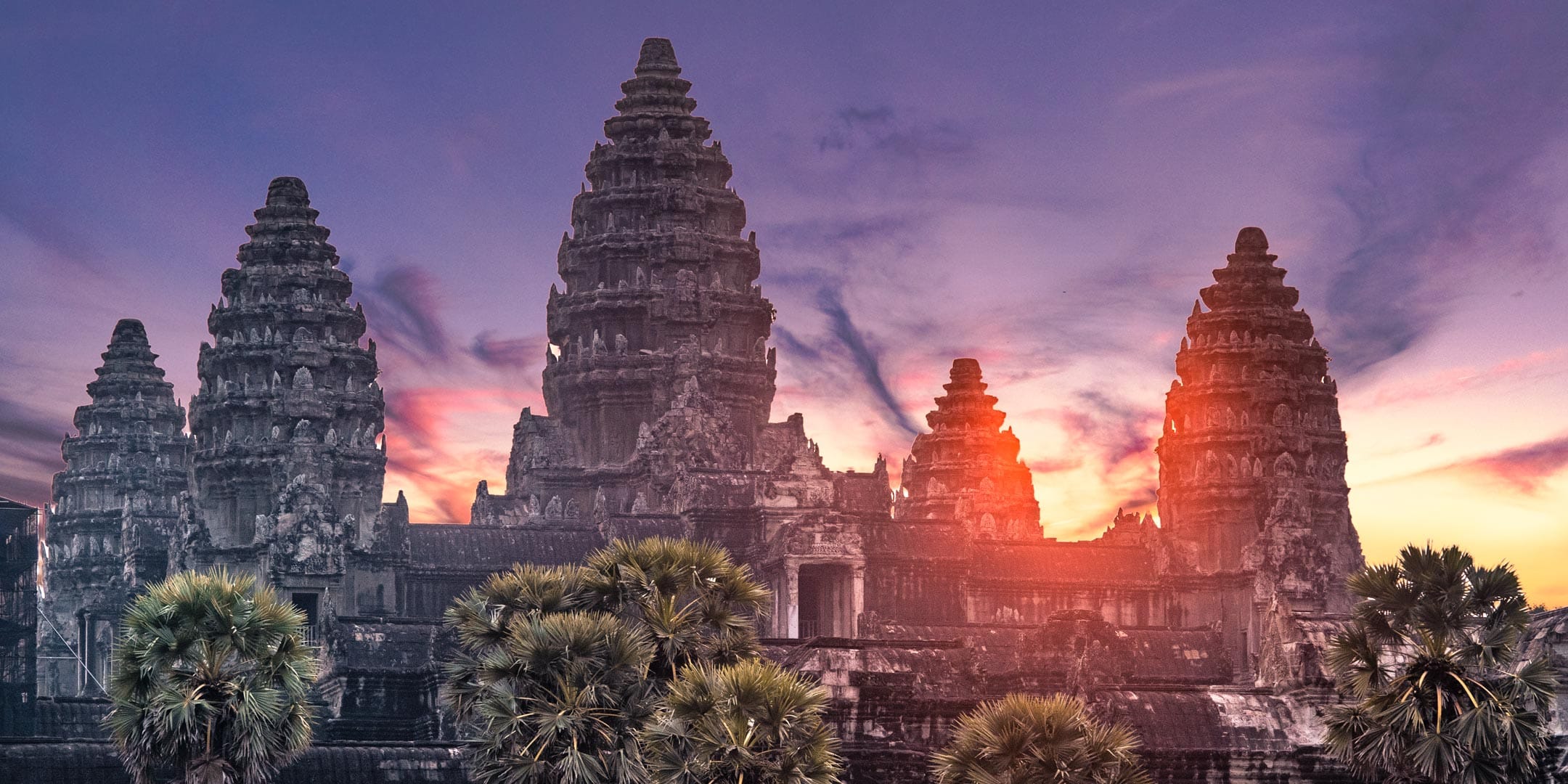
TA PROHM. Part of the Angkor Wat complex (which is mostly Hindu), this Buddhist monastic complex reminds you of the power of the jungle. It looks much like most Angkor temples looked when European explorers first set eyes upon them – crumbling towers and walls locked in the embrace of centuries-old trees. Tree-in-temple photos show the iconic views of trees growing from the top of walls and their roots enveloping whole sections. A huge gallery has been reconstructed with fascinating before and after pictures.
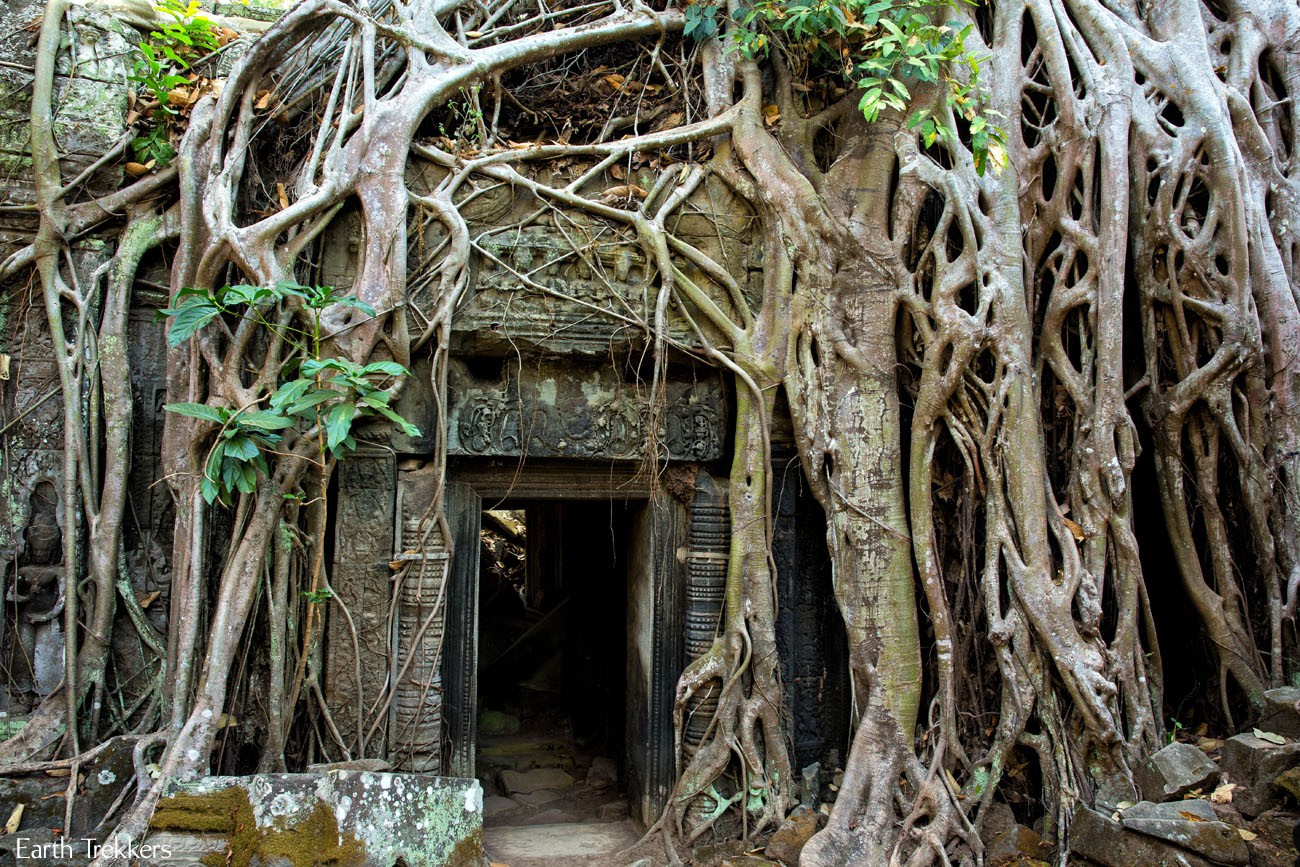
Baphuon. Some have called this the world’s biggest jigsaw puzzle. Before the civil war, the Baphuon was painstakingly taken apart piece by piece by a team of archaeologists, but their meticulous records were destroyed during the Khmer Rouge madness. After years of excruciating research, it has been restored by finding all the blocks spread throughout the forest. One of the biggest challenges was the retaining wall on the western side was fashioned in the 15th century into a reclining Buddha 60m in length.
Preah Khan or ‘Sacred Sword’, built in 1191, is one of the larger complexes and was built by Jayavarman VII. It housed 1000 teachers and may have been a Buddhist university. Surrounded by a rectangular 700x800m wall and a moat, the temple is a cruciform maze of vaulted corridors, fine carvings and lichen-clad stonework. The southern corridor is an atmospheric jumble of vines and stones. The center of the cross contains a Buddha image, but all the corridors contain Shiva linga and defaced Buddha images done during the Hindu resurgence.
Neak Poan, ‘coiled serpent from the encoiled nagas that encircle the temple’, another of Jayavarman VII’s constructions, is a small temple located on an artificial, 350m square island in the middle of the last baray built in Angkor (3500x900m). Reached via a long bridge over water almost completely overgrown with trees, the central temple sits at the axis of a lotus pattern of eight pools. Water once flowed into the pools by 4 ornamental spouts in the form of an elephant’s head, a horse’s head, a lion’s head and a human head.
PHNOM PENH
Silver Pagoda in the Royal Palace is the real attraction in the palace, housing a treasure trove of Buddha images. Besides a jade Buddha, there is the magnificent full-size Buddha made of 93kg of solid gold. It is covered with over a thousand diamonds. It is called the Silver Pagoda because the floor is made of silver tiles weighing 2kg each.
Wat Ounalom is is not remarkable except the closed stupa in the back has an eyebrow hair of the original Buddha!!! Buddha relics are a big deal and every country has some hair or tooth relic – this all seems like hogwash to me.
VIETNAM
Jade Emperor Pagoda, Ho Chi Minh is a gem among Chinese temples representing both Buddhist and Taoist religions. It is filled with phantasmal divinities and grotesque heroes and has some wonderful wood carvings. Two pools outside each have carp and wall-to-wall turtles.
Long Son Pagoda, Nha Trang is impressively adorned with glass and ceramic dragons. It has a great selection of bells in the shape of wood animals and large bronze bowls with wonderful tone. At the top of a hill behind the pagoda is a gigantic seated Buddha. Around the base of the statue are relief busts of 7 Buddhist monks who died in self-immolations protesting the Vietnam War in 1963.
Dieu Do National Pagoda, Hue is a bastion of dissent against the South Vietnamese government with its Catholic, prejudiced Prime Minister during the War.
Thien Mu Pagoda, Hue is a 7-tiered, 21m high octagonal tower, and has a ‘normal’ Buddha, a Chinese Happy Buddha, an enormous stele sitting on a giant marble turtle, and a wonderful bonsai garden.
JAPAN
Tochije Temple, Fukuoka has the biggest seated wood Buddha in the world. Under the statue is a walkway with dioramas of hell and the darkest tunnel.
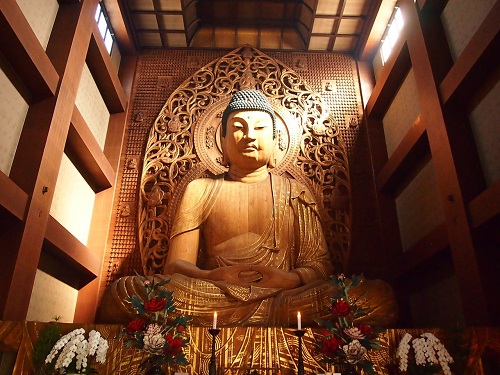
KYOTO
Jodo Shin-shu (Pure Land) School of Buddhism headquarters with 10,000 temples and 12 million followers worldwide. Two huge temples.
To-ji (Unesco, 794/17th century) Shingon school of Buddhism (Esoteric Buddhism). Great Buddha images in poses I have never seen before. A 57m high, five-story pagoda is the highest in Japan.
Kiyomizu-dera (Unesco, 798/1633), of the Hosso school of Buddhism, has a lovely location at the foot of the mountain above a waterfall.
Chion-in (1234/17th century) represents the Jodo or Pure Land sect of Buddhism, the most popular sect in Japan, and this temple is the most popular pilgrimage site in Kyoto, has the biggest temple gate in Japan and the biggest bell in Japan at 70 tons.
Shoren-in (16th century/1895), Tendai school of Buddhism, giant camphor trees, temple and gardens.
Nanzen-ji (1291/17th century), Rinzai school of Zen Buddhism, massive gate with steps to the second story, temple, tea room, and gardens.
Kinkaku-ji (Unesco, 1397/1955) – This is one of Japan’s best-known shrines and is very busy. This is the famed ‘Golden Pavilion’, burned to the ground by a monk in 1950, rebuilt and then the upper two stories were covered in gold leaf in 1987. The pond fronting the temple and gardens are stunning.
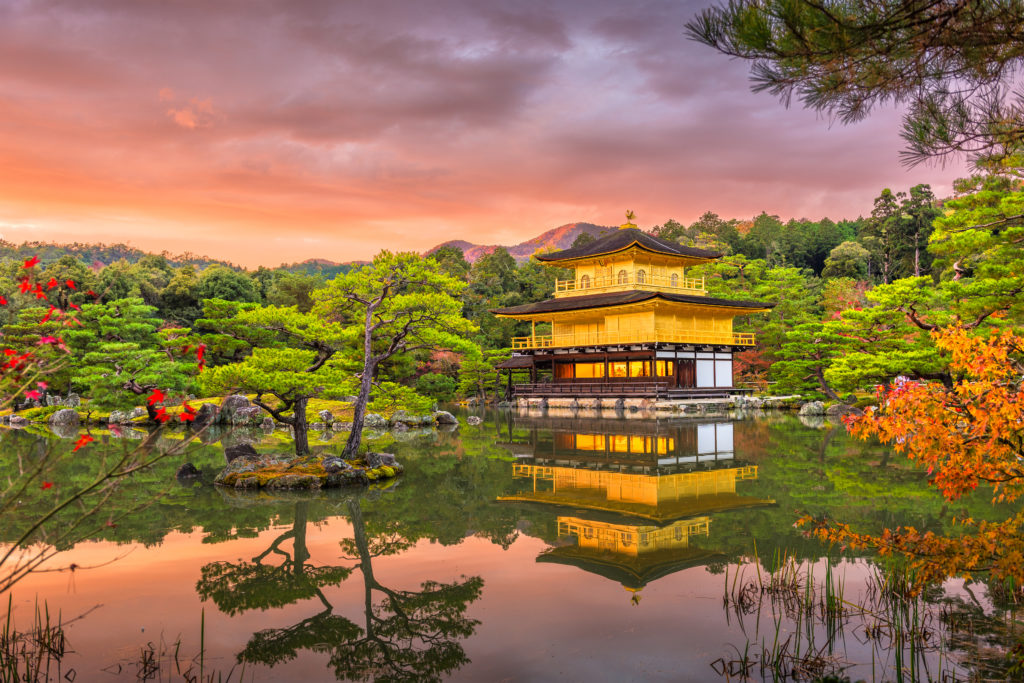
Ryoan-ji (Unesco, 1450), Rinzai school of Zen Buddhism. The main attraction is a garden with an austere collection of 15 rocks arranged in 5 groups surrounded by a small border of moss and an ocean of raked white gravel. No one knows the meaning of the composition. There is also a large pond and gardens.

Ninna-ji (Unesco, 842/17th century), Shingon school of Buddhism. Several temples, a five-story pagoda, and grounds with cherry trees.
Tenryu-ji (Unesco, 1339/buildings 1900), Rinzal school Buddhism. The main attraction is the original Zen garden centred around a lake with a hill behind it.

NARA (pop 370,000) was the first permanent capital of Japan. Shinto taboos concerning death stipulated that the capital be moved with the passing of each emperor but this practice died out when Buddhism was introduced and the country came under imperial control in the 7th century. It was the capital for only 75 years from 710-785 when a priest seduced the empress and it was moved to Kyoto out of the reach of the powerful clergy. Nara was spared the periodic bouts of destruction wrecked upon Kyoto and many magnificent sites survived with eight of them Unesco World Heritage Sites. All the sites can be seen in an easy day.
Most of Nara’s important sites are in a huge park that occupies the east half of the city. The park is home to thousands of deer, all habituated and tame. The crowds feed them regularly and then wonder why the deer get aggressive. All the deer have had their antlers removed. In pre-Buddhist times, the deer were considered messengers of the gods and today enjoy the status of National Treasures.
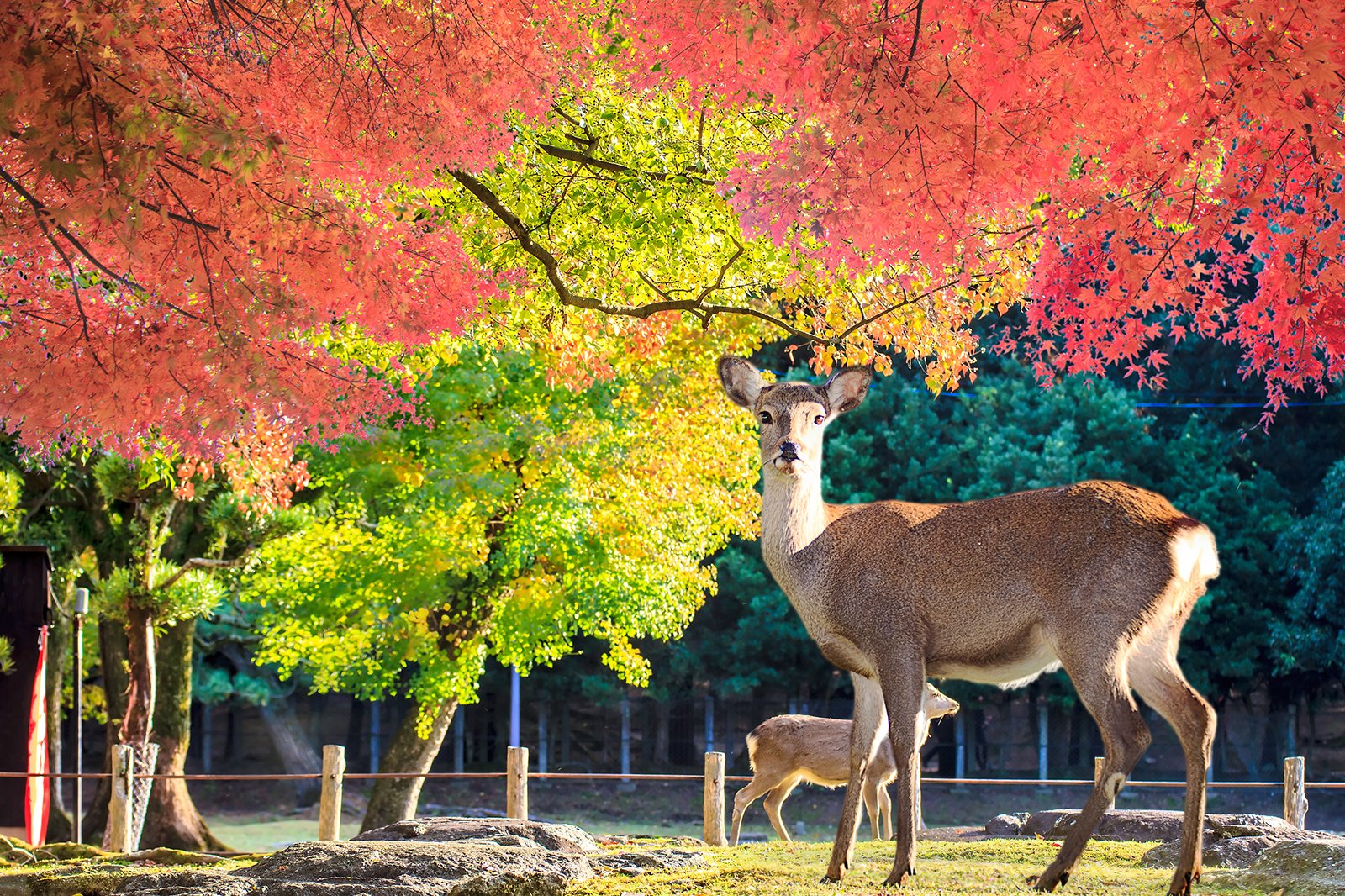
Yoshiki-en is a free garden just outside the gates.
Isui-en. Next door is another garden dating from the late 1800s. It is the best garden in the city and has a lovely pond and water features. The great south gate has two fierce-looking guardians carved in the 13th century. They may be the two finest wood carvings in Japan, if not the world.
TODAI-JI is the complex containing Nara’s famous Great Buddha and the city’s star attraction. At 14.6m high, it contains 437 tons of bronze and 130kg of gold and is one of the world’s largest bronze Buddhas. It was cast in 746 in eight castings for three years. Its hands send the message ‘fear not’ and ‘welcome’. It was originally covered in gold leaf and must have had an enormous impact on its Japanese visitors in the eighth century. It is believed that it was made as a charm against smallpox, which ravaged Japan in the preceding years. Over the centuries, the statue took quite a beating, losing its head a few times in earthquakes.
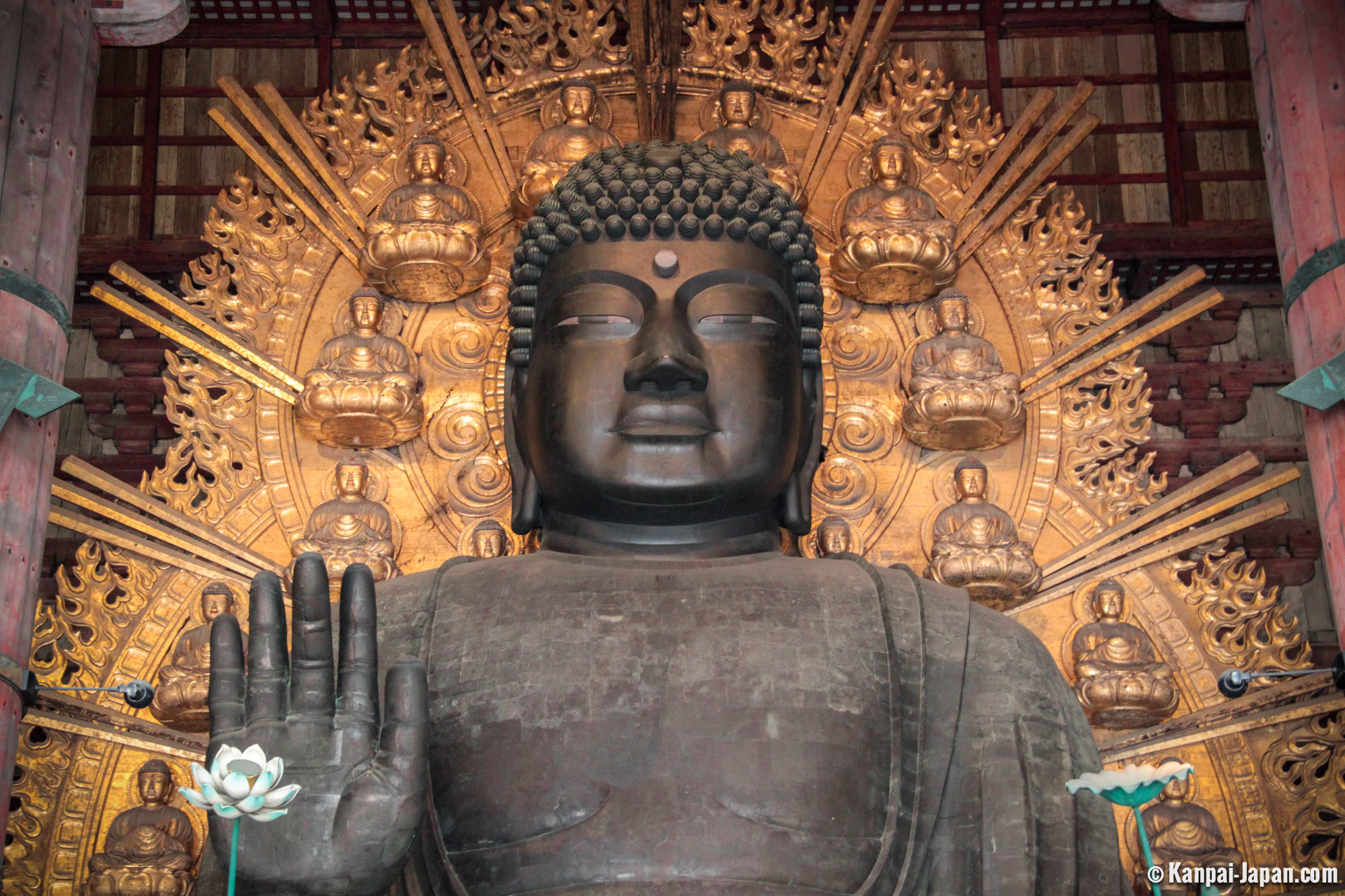
The statue is housed in an equally huge building, the Daibutsu-den Hall, the world’s largest wood building at 48.74m high, 57m long, and has 112,589 roof tiles. Unbelievably, the present structure, rebuilt twice (last in 1709), is a mere two-thirds of the size of the original. Todai-ji was built by order of the Emperor during the Nara Period (710-785) and the complex was finally completed in 798 after the capital had been moved from Nara to Kyoto. Legend has it that two million labourers worked on the temple and its construction brought the country to the brink of bankruptcy. Also in the hall are four other great figures.
HORYU-JI is an amazing Unesco Site. Founded in 607 by Prince Shotoku, the patron saint of Japanese Buddhism, Horyu-ji is renowned as not only being the oldest temple in Japan but also several of its great wooden temple buildings that have survived earthquakes and fires to become the oldest wood buildings in the world. Many of the statues in the temples date from the 7th century. A treasure hall contains a great display of equally old stuff that is much more interesting than the average museum.
NIKKO
Tosho-gu was the work of 15,000 artisans from across Japan who took two years to build it. Inside the shrine gate are three sacred storehouses, a sacred stable (engraved with the three famous monkeys of “hear no evil, see no evil, speak no evil” fame, the three principles of Tendai Buddhism), a hall, a hall of worship, a famous wood carved sleeping cat (hard to know what they get excited about with this one), the three Buddha hall and finally the Tomb of Ieyasu up a big flight of stairs.
Rinno-ji is a shrine constructed of 360 zelkova trees and has three 8m gilded Buddhas.
TOKYO
Senso-ji is Tokyo’s most visited Shinto shrine and crowds and tours packed the area. It supposedly enshrines a golden Kannon image (the Buddhist goddess of mercy) but it is not on public display and it is a mystery if it even exists!
CHINA
BEIJING
Forbidden City. Ringed by a 52m wide moat and imposing high crenellated grey brick walls, the Forbidden City is China’s largest and best-preserved collection of ancient buildings. With 9000 rooms and 35 Buddhist worship areas, it is also the world’s largest palace complex. It was named ‘Forbidden’ as it was off-limits for 500 years and uninvited guests were executed. It was the reclusive home to both the Ming and Qing dynasties until overthrown in 1924.
Summer Palace. Climb Longevity Hill to the Buddhist Fragrance Pavilion and the Buddhist Temple of the Sea of Wisdom for great views down to Kunming Lake through the smog-induced haze. Walk down to the lake, turn right and walk by Cixi’s marble boat and the fine Qing boathouses.
Lama Temple. This exceptional Tibetan Buddhist temple, the most important one outside of Tibet, is the one temple to visit in Beijing. After passing through a lovely garden, multiple halls culminate in the Wantu Pavilion with its magnificent 18m-high statue of Maitreya Buddha sculpted from a single piece of white sandalwood. All the halls have riveting roofs, frescoes, tapestries, and eye-popping carpentry. Small side halls have great displays of Buddhist treasures. Today it is an active place of worship attracting pilgrims from afar.
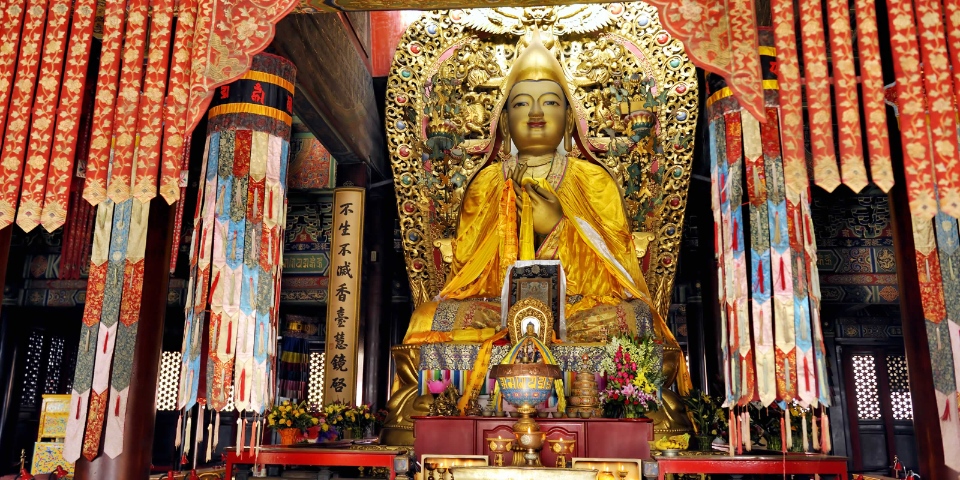
DATONG Shanxi
Huayan Temple is an active Buddhist temple (907-1125) and has some of the largest Buddhist halls in China. Shanhua Temple has five Buddhas and celestial generals. I did not go to these sites.
YUNGANG CAVES
Unesco listed as one of China’s best examples of Buddhist cave art, they were carved over 60 years from 460 to 520 AD by the Turkik-speaking Tuoba people (Upper Wei dynasty 386-534 AD). There are 51,000 ancient statues, 254 carved niches, and 45 caves of which #9, 10 and 40-45 were closed. Amazingly, they still retain their gorgeous pigment. Some are fronted with wooden temples, some contain intricately carved wooden pagodas and others have central carved stone pagodas. Frescos of Buddhist scenes, animals, birds and angels, some still brightly painted, are abundant. Eight caves contain enormous Buddha statues, the largest is seated and 17m-high. Some of the caves are three levels high and the big Buddhas stare out of windows cut into the rock. Some of the carvings are exquisite including many 1000 Buddha walls and a 30-scene depiction of Buddha’s life. Unfortunately, there is some graffiti, weathering and removal of heads. There are good English captions outside each cave.
The entire complex has been spiffed out in grand style – a huge entrance gate, a huge entrance pavilion with shops and restaurants, an entrance walkway with 28 large stone columns sitting on elephants, a big temple complex with 3 halls on pilings in the middle of a lake, long stone walkways, and stone fences.
Yungang Caves receive few foreign visitors but are well worth it. I feel like I have seen every Buddhist site in the world and this one is right up there with the best.
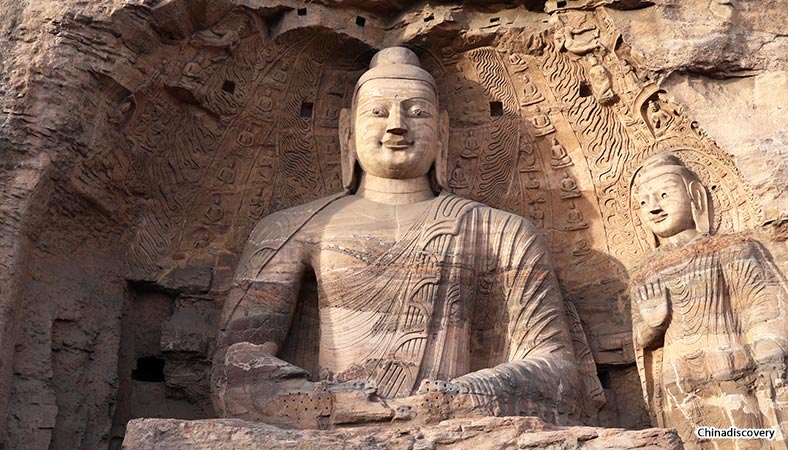
SHAOLIN. In Taoism, Song Shan is regarded as the central mountain symbolizing the earth. Near it is China’s most famous Zen Buddhist temple, Shaolin, but it has been reconstructed since a fire destroyed it in 1928. I did not visit this.
LONGMEN CAVES. Near Luoyang, the capital of 13 dynasties, are the Unesco-listed Longmen Caves containing 100,000 carved images and statues of Buddha. Many of the effigies have been vandalized or decapitated with the heads now residing in museums in America and Japan. The White Horse Temple is the first Buddhist temple in China dating from the 1st century AD.
BIG GOOSE PAGODA, Xi’an I went to a light/fountain show outside the pagoda one night – it was nothing special. The pagoda is Xi’an’s most famous landmark. It was completed in 652 to house Buddhist sutras brought from India (a translation that took 19 years is still in use today).
Wenshu Temple, Chengdu a Tang dynasty monastery, to hear the monks chant at 18:00.
LESHAN
Grand Buddha at Leshan. This is the largest Buddha statue in the world. The 1200-year-old statue is carved into a cliff face overlooking the confluence of the Dadu and Min Rivers. And at 71m, he is big. His ears stretch for 7m, his shoulders span 28m, and each of his big toes is 8.5m long. A Buddhist monk conceived the project in AD 713 and took 90 years to complete. Inside the body, hidden from view, is a water-drainage system to prevent weathering. He is showing his age and soil erosion is an ongoing problem. To appreciate his magnitude, get an up-close look at his head, then descend the steep, winding stairway for the Lilliputian view. Avoid weekends and holidays, as crowds on the stairway bring the pace to a standstill. I was first at the ticket booth and first at the Grand Buddha. Other tourists had complained of the enormous queues (up to an hour and a half) at the Buddha, but I had it all to myself (in fact I didn’t see another tourist all day). He is big, and covered with ferns and plant growth. After the climb to the top from the ticket booth, one descends on a very steep walkway cut into the cliff with ancient carvings on one side and the Buddha on the other. A funny sign about not throwing garbage down into the river said “No Parabolics” referring to the arc of something being thrown.
The exit is on the other side and is the beginning of the up-and-down Cliff Road to see all the other sites including a fishing village.

Mahaoya Tombs. 500 monks were buried here in the honeycomb caves; there is a nice small museum with pottery animals, kitchenware, lesser functionaries, and massive, intricately carved stone coffins.
Wuyou Temple. After crossing a lovely domed bridge to an island, it is another stiff climb. It was also built in the Tang dynasty. A monk got pissed off when I hit the large wood tortoise gong more than once (I can’t resist these and the great brass bowl ‘bells’ with their perfect tone). Contrary to Buddhist monks in SE Asia where many young men go to acquire an education and who all speak English, these monks were a fairly ignorant lot.
Luohan Hall. Beside the temple, this contains 500 completely different life-sized, terracotta celestial beings all with different postures and facial expressions. The hall also contains a fantastic 1000-armed statue of Guanyin, the Chinese Goddess of Mercy (Avalokiteshvara in Sanskrit).
Oriental Buddhist Theme Park On this, the opposite side of the mountain from the Buddha, tombs and temples recently constructed housing 3000 Buddha statues including a 170 m–long reclining Buddha, the world’s largest. I didn’t go. This is not a day for the unfit as there are a lot of stairs.
DAZU BUDDHIST ROCK CARVINGS
Don’t miss these. I have many things Buddha, but Dazu is one of the best. There are many sites around Dazu but only two are commonly visited and I did not go to the other, North Hill.
Baodingshan Rock Carvings (Treasured Summit Hill). Carved from 1174-1252, thousands of figures were carved into a U-shaped cliff. Unesco World Heritage listed, they are the most recent of China’s best sites, but the artwork here is arguably the best. There are 14 big niches under overhangs and two caves with thousands (supposedly 50,000) figures depicting the entire Buddha story. Many still have original paint, mostly blues, reds and gold.
The highlights are esoteric Buddhism, a depiction of Hell like in many Catholic churches (think torture, boiling cauldrons, and gruesome figures), the Buddhist happy world, parental love, the peacock king, nine dragons, water from a pond above channelled into a dragon’s mouth bathing a baby Buddha, Buddha entering nirvana (a 31m lying Buddha with only the upper torso carved), and the most amazing one of all is a gold Avlokiteshvara (or Guanyin, the Goddess of Mercy) with 1007 hands fanning out from her, entwined and reaching for the skies. Each hand has an eye, the symbol of wisdom. (This is fronted by a wood temple under renovation for the last 4 years so I had to show a lot of effort to see most of it).
Following this are the three Huajin saints (one holds a 500kg pagoda in his hands – the sculpture cleverly uses draped clothing to support the arms), the Buddhist Wheel of Life, buffalos (10 water buffalos show the gradual process of taming mental activities), and finally the Cave of Enlightenment. It is quite a show.
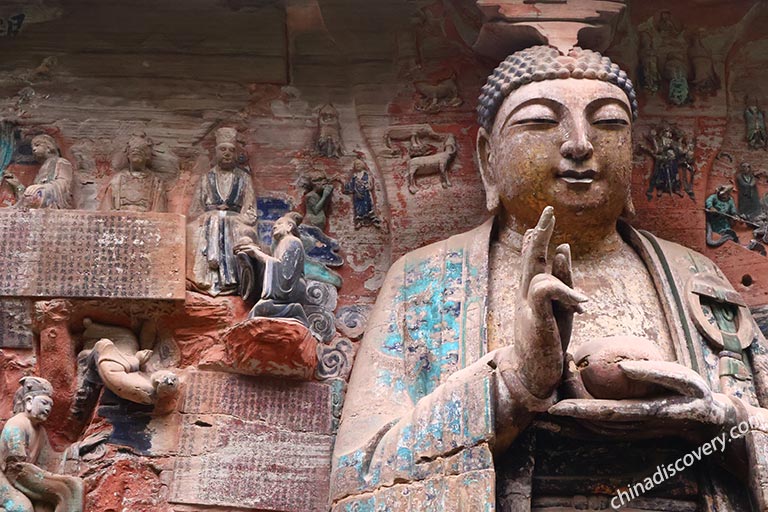
After cresting the hill, there is a great temple. When I arrived, 4 monks were chanting with at least 80 old women doing salutations. Outside were two groups of old ladies knitting and making cloth shoes. They were fun to josh with.
Arhat Temple, Chongqing (a Buddhist temple now sandwiched between skyscrapers)
Fengdu. On the Three Gorges Dam Cruise, after passing the drowned town of Fuling, we arrived at Fengdu, 170 km from Chongqing. Nicknamed the City of Ghosts, it was inundated in 2009 and its residents moved across the river.
Ming Shan with its ghost-focused temples. We climbed to the top of 400 steps through many Tao/Buddhist temples, the most recent reconstructions since the 2008 earthquake. They are all about heaven and hell, a recurring theme in most religions. We passed over the middle of three bridges to see if we passed the test. The most amazing was at the very top with gruesome depictions of torture and evil.
SHIBAUZHAI PAGODA This is a 12-story, red, wooden pagoda, 56m high, built and leaning against a big chunk of rock. The bottom nine stories were originally built during the Ming dynasty (1368-1644) and the top three stories above the height of rock were added in 1956. The stairs inside the pagoda pass by steles and statues of deities and generals. Architecturally unique, it has round windows and is built without nails. The duck well proved that the well was connected with the river after a duck was put down the well and appeared in the river. The rice flowing well provided free rice until a greedy monk enlarged the hole stopping the flow of rice forever proving that greed doesn’t pay. Views from the temple on top are panoramic. Since the dam was built, the climb is now 175m less than originally and the rock and pagoda is now an island reached by a swaying suspension bridge called the ‘drunken bridge’.
LUSHAN One of the great early monastic centers of Chinese civilization, the dramatic fog-enshrouded cliffs of Lushan have attracted monastics and thinkers for 1500 years. The monk Hui Yuan, one of the first Chinese teachers to promote meditation, founded Pure Land Buddhism here in the 4th century. Tao Yuanming, a contemporary, was China’s first landscape poet.
TIAN TAN BUDDHA STATUE, Hong Kong. At 26m, this is the world’s tallest seated Buddha (this is what they say, but Buddha Point in Bhutan is significantly larger at 50m). Take the metro to Tung Chung and then the cable car. This must be the longest cable car in the world as it makes two turns and goes over a mountain and is relatively expensive at HK$180. It was a 2-hour wait to get onto the cable car as I went in the early afternoon, so I went early to beat the crowds. Walk through a lot of souvenir shops to get to the base of the Buddha, then a long stair to the statue. If I had not collected all things Buddha, this may have not been worth it. Consider taking the tram up and then walking down (2-3 hours).
MAIJI SI. 35 miles SE of Tianshui is “Haystack Mountain” whose cliffs are riddled with niches and statues carved from AD 389-581. On my quest to see everything Buddha in the world, I am glad I did not miss this one. The 221 caves and 1000 statues on the vertical cliff face are accessed by catwalks and stairways cross-crossing the cliff. Most of the statues are made of clay with elaborate clothing and detailed painting. Six large statues, the biggest at 15.7m, adorn the cliff outside of the caves. How all this was carved remains a mystery – it is thought that they worked on piles of wood blocks. These caves were heavily defaced by the Red Guards in the Cultural Revolution.

BING LING SI, Liujiaxia. Because of its inaccessibility, this was one of the few Buddhist grottos to have survived the 20th century unscathed. Over 1600 years, workers dangled from ropes to carve 183 niches and sculptures in the sandstone of the steep canyon walls. The stars of the site are the 27m high, seated statue of Maitreya, the future Buddha, and a 9m reclining Buddha. But much of the rest of the carving is exquisite and a lot of the paint is still bright. Just below the grottos, the canyon ends at the reservoir on the Yellow River, hemmed in by a ring of dramatic rock pinnacles.
There are two ways to get there – a one-hour boat ride ($17) or a taxi, highly recommended because of the spectacular scenery. We climbed high above Liujiaxia through terraces laddering every inch of tillable ground on the barren, dry hillsides. Potatoes and corn are the main crops. Looking down, there was an impossibly steep, narrow, rutted dirt track descending into the rugged canyon below. To my surprise, that was the route to the grottos. The landscape was stunning with erosional features, pinnacles and rock towers. The ideal trip would be to take the boat one way and a taxi the other, but I doubt this is logistically possible.
LABRANG MONASTERY, Xiahe. This monastic town attracts many tourists. Most are rural Tibetans, here to pray and seek spiritual fulfillment. The Xiahe area was once part of Tibet. Labrang Monastery was founded in 1709 by the first generation of a line of living Buddhas ranking third in importance after the Dalai Lama and Panchen lamas. Labrang is one of the six major Tibetan monasteries of the Yellow Hat sect of Tibetan Buddhism (the others are Danden, Sera and Drepung monasteries near Lhasa, Tashihunpo Monastery in Shigatse and Kumbum near Xining, Qinghai). At its peak, it housed 4000 monks, but the number greatly declined during the Cultural Revolution (called the anti-feudal revolution). Numbers are recovering and are currently restricted to 1800 monks, drawn from Qinghai, Gansu, Sichuan and Inner Mongolia.
Access to most of the monastery is free and you can spend hours walking around and soaking up the atmosphere in the endless maze of mud-packed walls. One of the best experiences is to show up between 6 and 7 am for the monk’s morning prayers. Walking the korais one of the highlights. This 3km path encircles the monastery and is the best way to grasp the layout, scale and significance of the monastery. Lined with long rows of squeaking prayer wheels, whitewashed chortens (Tibetan stupas) and chapels (many closed), most of the pilgrims on the kora appeared to be Tibetan with darker skin, traditional dress and a different facial appearance. Most were old and some amazingly frail. Beggars were frequent. The 3-story Barkhangis the traditional printing press with 20,000 wood blocks used for printing. The Gongtand Chorten has access to the roof for views over the entire monastery. Tibetan monasteries are almost equal to the ones in Bhutan for opulent decoration: brilliantly painted frescoes, embroidery and carving.
Besides the kora, several main buildings require a tour: the Institute of Medicine, Manjushri Temple, Golden Temple, Prayer Hall, and a museum of relics and yak butter carvings.
Great Buddha Temple. Originally dating to 1098, this huge temple contains a 35m-long sleeping Buddha – the largest clay-covered, wood-core Buddha in China (I guess this is a big deal). Until the 1960s children could play inside the tummy of the Buddha. The main hall is one of the few wooden structures from this era still standing. The doors and woodwork are exquisite.
MOGAO CAVES, Dunhuang. A Unesco World Heritage Site, these are one of the greatest repositories of Buddhist art in the world. First started in 368 AD, the site at its peak had 18 monasteries, more than 1600 monks and nuns, and countless artists, translators and calligraphers. Wealthy traders and important officials were the primary donors responsible for creating new caves, as caravans detoured to Mogao to pray and give thanks for a safe journey through the treacherous wastelands to the west. They were largely forgotten from 1300 until the 20th century when they were “rediscovered” by many foreign archaeologists from 13 countries who visited and took priceless items (especially the 20,000+ manuscripts found in the library cave).
Mogao is 10kms east of town near the railway station and is most cheaply visited on one of the free city buses. In busy seasons, it is recommended to reserve tours as this is an incredibly popular place. It is also expensive like most good sites in China – 220 yuan ($38). One starts with two excellent films (make sure to get the English headsets), one shown in a theatre with a huge round screen on the ceiling (think planetarium). You then get a free English-speaking guide and I had her all to myself. The in-season tour includes 6 of the 492 caves (20 are rotated regularly) but they are all spectacular.
Northern Wei, Western Wei and Northern Zhou Caves. These earliest caves are distinctly Indian in style and iconography with central pillars representing a stupa, and slim statues with finely chiselled features. Lead-based paint, initially white, is oxidized to black. Sui Caves (581-618) still have Indian features. The 230 Tang Caves (618-907) were the high point as the Tang pushed China’s borders westward into Kazakhstan bringing diverse trade. The murals are still beautiful with the paint, especially on the ceilings, is remarkable. There are also two big Buddhas, one 26m tall and one 34.5m tall – a Maitreya Buddha, making it the world’s third largest Buddha. The post-Tang Caves introduced Tibetan influences. The Library Cave (#17) was discovered in 1900 (the room was completely disguised) with tens of thousands of immaculately preserved manuscripts dating to 406, texts of rare Central Asian languages, military reports, music scores, medical prescriptions, Confucian and Taoist classics, Buddhist sutras and the oldest printed book in existence, the Diamond Sutra (AD 868). Almost all were removed to the West. An excellent museum is outside the cave telling the whole story.
Another good museum worth visiting is the Research Centre where 8 caves are meticulously reproduced.


LHASA. Lhasa is the traditional, political and spiritual center of the Tibetan world.
BARKHOR. It’s difficult not to be swept up in the tide of humanity that is Barkhor, a kora or pilgrim circuit that winds clockwise around the Jokhang Temple. The crowd of pilgrims is captivating – they come from all over Tibet. White ovens bellow the smoke of incense burning. The most impressive were two men prostrating themselves every few meters – wood and metal sliders on their hands.
Jakhang Temple (85¥). This 1300-year-old, Unesco-rated temple is the spiritual heart of Tibet with the continuous movement of pilgrims prostrating themselves outside. The golden roof lines foretell the ancient interior with frescoed walls and carved pillars. The central golden Buddha here is the most revered in all of Tibet.
POTALA PALACE. Once the seat of the Tibetan government and the winter residence of the Dalai Lama, it is Lhasa’s cardinal landmark. The first site of the towering maroon, yellow and white fortress-like walls will be remembered for a long time. An architectural wonder even by modern standards, the palace rises 13 stories from the top of a 130m-high mountain and contains more than 1000 rooms.
The first recorded use of the site dates from the 7th century when a palace was built here. Construction of the present structure began during the reign of the 5th Dalai Lama in 1645 and took more than 50 years to complete. Zhou Enlai sent his own troops to protect it from the Red Guards during the Cultural Revolution.
The layout includes the rooftop White Palace used for government and the residence of the Dalai Lama, and the central Red Palace used for religious functions. The most stunning chapels house the jewel-bedecked golden chorten tombs of previous Dalai Lamas. The apartments of the 13th and 14th Dalai Lamas in the White Palace offer a more personal insight into life in the palace.
Before we went into the Potala Palace, we had some time to wander around. I parked myself on a bench on the kora that goes around the palace. This may be the best people-watching in the world as pilgrims from all over Tibet come here. Prayer beads are in the left hand and a prayer wheel twirling in the right. Most are older and many are truly ancient but spry for their apparent age. Their skin was dark and leathery. But others are stooped with slow shuffling gaits, limps, using canes or crutches and their determination to walk the kora is impressive. Traditional dress varies but is most often a long skirt with a colourful striped apron and multiple necklaces’ of turquoise, amber, coral, glass and wood. Some push baby strollers.
Drepung Monastery (30¥). 8 km west of the old town, it was purportedly the largest monastery in the world with around 7000 resident monks at its peak. The kings of Tsang and the Mongols visited regularly, though oddly, the Red Guards pretty much left it alone. Around 600 monks reside here now.
Sera Monastery (60¥). 5 km north of central Lhasa, it was founded in 1439, and along with Drepung, was one of the great Gelugpa (Yellow Hat) monasteries. 600 monks, down from 5000, reside here. The spectacular prayer halls had ornate carvings and metalwork backing up the many Buddha images. In the afternoons, you can see Tibetan-style religious debating with lots of hand slapping and gesticulating.
West of Lhasa, the people practice natural burial systems: either chopping up and putting the bodies in the river or sky burials where the bodies are eaten by birds. The bones are then collected, cremated and the ashes put in the river.TASHILHUNGO MONASTERY, Shigatse. Since the time of the Mongol sponsorship of the Gelugpa (Yellow Hat) order, Shigatse has been the seat to the Panchen Lama, the second highest-ranking lama in Tibet. One could view the Dalai Lama, stationed in Lhasa, as the political leader and the Panchen Lama as the religious (and more scholarly) leader.
This is one of the six great Gelugpa monasteries (along with Drepung, Sera and Ganden monasteries in Lhasa, Kumbum in Qinghai Province, and Labrang in Gansu). Built in 1447, the monastery is the size of a small village. It is divided into four main chapels. The Temple of Maitreya contains the 27m statue of Jampa (Maitreya) Buddha, the largest copper-gilded Maitreya Buddha in the world. The other three chapels contain the chorten tombs of the 4th, 10th, and 5th to 9th Panchen Lamas). All opulent, they are silver and gold (the 10th is covered in 500kg of gold) structures encrusted with jewels. The metal work is outstanding with the four directional gods on the sides. A simple turquoise, glass and precious stone swastika is embedded in the floor outside one of the chapels.
SAKYA. In the 14th century, this monastic town, with the help of Mongol military support, became the short-lived ruler of all Tibet. The main monastery, built in 1298, is a massive fortress-like compound, with high defensive walls. The serene assembly hall is easily the most impressive of any we have seen: multiple Buddha images and tomb chortens displaying marvellous metal work. The hall also contains one of Tibet’s great libraries, with Buddhist manuscripts everywhere.
SHAGAR MONASTERY and FORT. Most people stay here for their last sleep before heading to Everest Base Camp, about 100 km south. Above the town is a monastery/fort with a defensive wall climbing the virtually vertical ridge. After walking to the monastery and snooping around, we climbed up to the wall with its crumbling battlements and red guard towers. Unfortunately, most of the wall had been destroyed in the Cultural Revolution.
Bongphu Monastery. A few kilometres from Everest Base Camp, this is the highest monastery in the world (5000m) and the first monastery in Tibet.
INDONESIA
BOROBUDUR. 42km NW of Yogyakarta, Borobudur is one of the most important Buddhist sites in the world and one of the finest temple complexes in SE Asia and is Unesco World Heritage listed. Constructed at the same time as Prambanan in the 9th century, it was abandoned as Buddhism waned and was covered in volcanic ash in the eruption of 1006. It was not rediscovered until 1814 by the British.
The temple consists of six square bases topped by three circular ones. The square ones have 1500 narrative bas-relief panels illustrating Buddhist teachings and 432 Statues of Buddha sitting in chambers on the terraces. On the upper circular terraces are 72-latticed stupas each containing a Buddha image. All is capped off with a large stone stupa. We walked around each terrace in a clockwise direction (most Muslims went the other way). The best way to see Borobudur is at sunrise when mists shroud the valley and crowds are small.
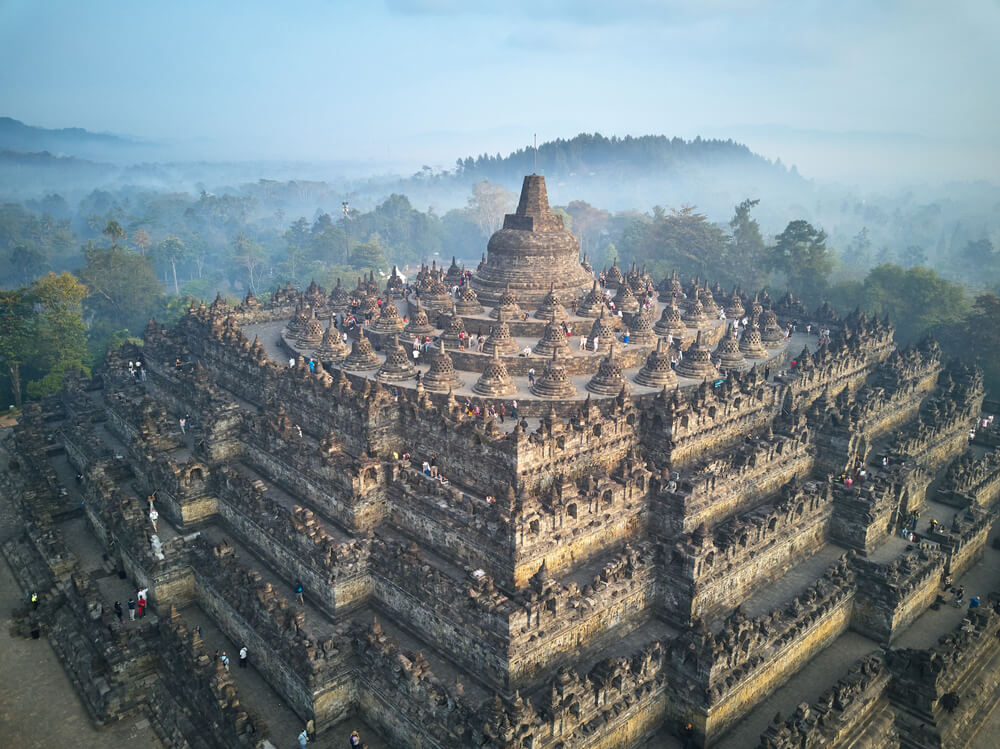

TAJIKISTAN
In the Antiquities Museum in the capital, Dushanbe is this 13m-long sleeping Buddha moved from Ajina Teppe in 1966, when Soviet archaeologists sliced it into 92 pieces. Dating from the Kushan era (around 500 AD), it is the largest known Buddha figure in Central Asia.
A model of the 7th-century Ajin-Tepe Buddhist monastery is in the National Museum.
SINGAPORE Feb 15, 2023
Buddha Tooth Relic Temple. This is a large temple with hundreds of scrolls and some impressive gold Buddhas. There was a “service” with about 30, mostly women, chanting from a prayer book. I saw no evidence of the tooth relic.
Of note, there are tooth, bone and hair relics of Buddha all over the place. It is unlikely that any are real.
THAILAND
The Big Buddha, Phuket is a seated Maravija Buddha statue sitting atop Nakkerd Hill near Chalong, construction occurred between 2015-18. It is the third-tallest statue in Thailand behind only the Great Buddha of Thailand and Luangpho Yai.
The Buddha statue depicts Gautama in a sitting position and is 45 metres (148 feet) tall and 25.45 metres (83.5 feet) wide. It is made of concrete and covered with Burmese white marble.

Wat Chalong. A collection of several Buddhist temples, the most spectacular is 3-stories with a high temple and spire on top, incredible window decoration, and many frescoes inside. Floor 1 has many seated Buddhas, floor 2 a seated marble Buddha and floor 3 crystal Buddhas in a glass case. The grounds are quite lovely.
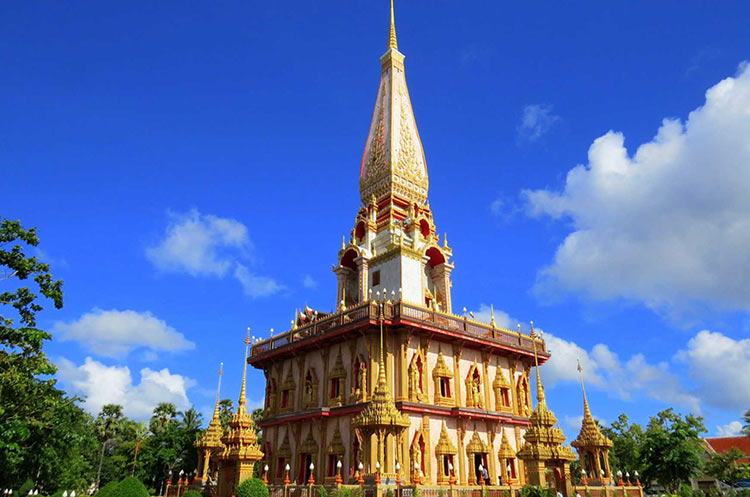
Wat Phra Thong. A Buddhist temple complex with two temples, only one of which is open. Unusually, 8 smaller Buddhas are being slowly covered with gold leaf.
Wat Benchamabophit (Marble Temple). Another over-the-top Buddhist temple but this one is all grey marble with ornate gilt/cut glass window and door frames.
Wat Saket (Golden Mount Temple). Built on a steep mountain with brickworks, shrines and water features). A relic of the Buddha was brought from Sri Lanka by Prince Pritsadang and placed in the chedi. The surrounding concrete walls were added in the 1940s to stop the hill from eroding.
Wat Bang Phli Yai Klang. A large Buddhist complex with many temples and housing, the main temple has a massive orange stupa on top of three floors. Inside is a very fat, happy Buddha, a large fibreglass Buddha and many frescoes.
SANCTUARY of TRUTH, Pattaya.is a hybrid of a temple and a castle that is themed on the Ayutthaya Kingdom, Buddhist and Hindu beliefs. The building is entirely wood – wood-carved idols and sculptures. The building has been under construction since 1981, and may not be finally completed until 2025.
A four-faced Hindu creator god Brahma statue on its rooftop. The Northern hall features Buddhist Guanyin and other sculptures featuring the wisdom of emancipation. The Southern Hall features astronomical themes, namely the sun, moon, and other planets impacting people’s well-being. The Western hall features representations of the classical elements (earth, water, wind, and fire) and sculptures of the Hindu Trinity: Lord Brahma, Vishnu, and Shiva, the gods who conquer the four elements. The Eastern Hall features familial representations. The main focus is to visually portray important Eastern religious concepts and the cycle of life.
Every surface of the structure is decorated with ornamentation from Thai, Hindu, Buddhist, Chinese, and Khmer traditions.
The wooden sanctuary is over 100 meters tall and makes for an impressive sight
ATV rides, cruises on traditional Thai gondolas, and controversial elephant rides. 400 B 
PATTAYA (pop 1 million). On the east coast of the Gulf of Thailand, about 100 kilometres (62 mi) southeast of Bangkok, Pattaya was a fishing village until the 1960s. Tourism began during the Vietnam War, when American servicemen began arriving. Pattaya is attractive to many retirees from other countries because of its climate and lifestyle, but lower living costs.
Wat Phra Yai (Big Buddha Temple). An 18-metre (59-feet) high golden Buddha statue overlooks Pattaya and Jomtien Beaches from its vantage point at the peak of Pratamnak Hill. A gentle staircase flanked with dragon-inspired railings leads to the elevated platform, where 7 smaller Buddha statues are also located.

Prasat Muang Tam. In the NM Vestiges of the Past series, this is 8km from Phanom Rung and much lower in elevation. It is a large complex with a great stone wall, and a central platform with 4 small temples, none interesting. The highlight is the four L-shaped ponds on each corner – lovely. I met three people from Ottawa here.
Prasat Sikhoraphum. In the NM Vestiges of the Past series, this is a platform with four small corner towers around one mid-sized central tower. A U-shaped lake surrounds the back. The only thing of interest is the central temple with its carved door frame, bas-relief above the door, a fantastic carving of gods and the 8-headed small icon inside. 50B
Wat Phrathat Nong Bua. Another over-the-top Buddhist temple but this one is unique with its very large square tapering stupa. Inside are four Buddhas on each side of a similarly shaped large gold stupa. Outside are many ornate lamp posts and stupas on each corner.
Luang Pho Yai (Wat Burapha Phiram), Roi Et. At 67m, this is the tallest standing Buddha in SE Asia. Giving blessings pose.
Phrathat Ya Khu. This is a single small monument with three levels of brick and a three-part chorten on top.
It is the largest chedi in the city of Fa Daet Song Yang (an ancient city in the Khmer period, now only the remains of clay bricks remain), which the villagers believed to be the relics containing the ashes of the elders that the townspeople respected. The rectangular base is from the Dvaravati period. Next up is the octagonal base, built in the Ayutthaya period. As for the bell body and the top part, it was built during the Rattanakosin period. 8 meters high from the base to the top. Around the Phra That, they found a parapet carved in reliefs about the Buddha’s history.
Phra That Phanom, its related historic buildings and associated landscape. Tentative WHS. According to legend, the temple contains Phra Uranghathat (the Buddha’s breast bone) enshrined, and as such, it is one of the most important Theravada Buddhist structures in the region. A festival is held at That Phanom to honour the temple. The week-long festival attracts thousands of people who make pilgrimages to honour the shrine.
The temple contains paintings illustrating traditional Thai proverbs.t was originally built in the 16th century, but according to legend, the first temple structures were built here a few years after the death of the Buddha by the five kings of the Mon kingdom, The chedi was built in the 10th century at eight meters in height. At the end of the 17th century, it was restored and raised to about 47 meters. On 11 August 1975, the chedi collapsed, caused by heavy rain and strong storms for several days, but was rebuilt.
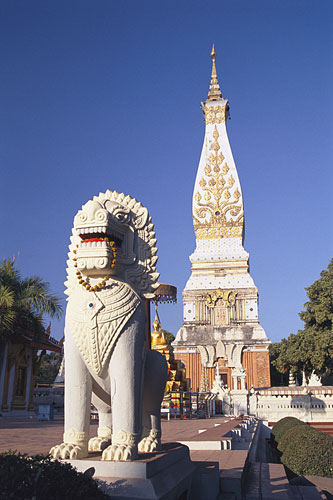
Phu Phra Bat Historical Park. The park’s distinguishing feature is its unusual rock formations around which religious shrines have been constructed. Some formations also feature prehistoric rock paintings.
The unusual rock formations in the park include spires, massive boulders and balanced rocks that form the backdrop for the prehistoric art and religious shrines created there. The geological origins of these rocks are thought to be from under-sea erosion that occurred fifteen million years ago. Prehistoric art paintings in natural shelters have oxen and human figures. The park’s rock paintings are believed to date from 6,000 years ago. Hor Nang Usa is one of a number of the rock formations where a shrine has been constructed. Early shrines date to the Dvaravati period in the seventh to tenth centuries. Shrines feature Hindu and Buddhist influences. The park’s most significant shrine is Wat Phra Putthabaht Bua Bok, where a Lao-style chedi covers a chamber housing a sandstone Buddha footprint. The shrine is a pilgrimage site with an annual festival held in March.
Wat Phra Bat Phu Pan Kham, Khuean Ubolratana. In the NM Religious Monuments series, the temple has a white gigantic Buddha image called Luangpho Yai or Luangpho Khao, of 14 metres in height. The Lord Buddha’s footprint can be found in a nearby area. The flight of 1,049 stairs leads the way up to the temple’s front. The temple overlooks beautiful views.
KHON KAEN
Hong Mun Mang Mueang. The aim of link every community in Khon Kaen together with historical information of Khon Kaen from past to present with the history and culture, the founding of the city, towns and lifestyles of Khon Kaen people, Khon Kaen today. 100B
Khon Kaen National Museum. In a beautiful space, there are antiques and artifacts in the northern part of Isaan – pre-historical period, the Davaravati Culture in Sri Thep town. The highlights are all the boundary stones, Khmer cultural Heritage with its Laterite and sandstone temples, Lan Chang Cultural Heritage, the history of Khonkaen town, and local Isaan art and ethnography. 100 B
Phra Mahathat Kaen Nakhon (Wat Nong Wang). Doors and windows of the 9-storey Stupa beautifully craved the former reincarnations of the Lord Buddha, 16 classes of visible deities in the Brahmas world, and Buddhist rites. On the top floor, where the Lord Buddha’s relics are located, are beautiful panoramic views of the city. I didn’t walk to the top of the 9 stories. Throughout the time I was there a monk chanted loudly magnified over loudspeakers. A head monk with two young monks entered, smiled at the subjects, was given a large chair and had photos taken of him. He seemed to be a very important guy.

Nam Nao National Park.
Pho Khun Pha Muang Memorial. Isolated standing dark bronze statue. The myth is that it protects travelers so honk when you pass.
Wat Phra Thart Pha Sorn Kaew. Mountain-top Buddhist monastery and temple covered in colourful mosaic tiles. Nice gardens.
The Ancient Town of Si Thep. Tentative WHS. Is an archaeological site about the ancient city of Si Thep, a site inhabited from around the third to fifth century CE until the thirteenth and spanning cultural periods from late prehistory to Dvaravati and the Angkorian Khmer Empire.
Wat Tham Suea (Tiger Cave Temple), Kanchanaburi. Sitting on top of a small hill, the fantastic roof lines can be seen from a long way off. There are several OTT temples and an 18m tall huge sitting Naga Buddha. Packed with tourists. I parked on top with lots of parking rather than down below where all the tour buses are. 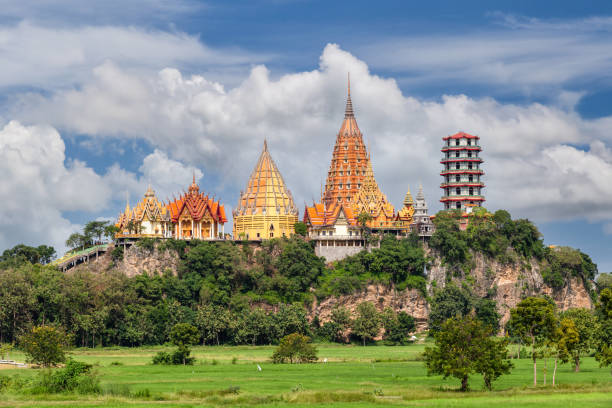
Wat Huay Mongkol, Thap Thai. Luang Por Thuat, a large Buddha image with a lap width of 9.9 meters, 11.5 meters high, and a 3-storey base. The first floor is 70 meters wide, 70 meters long,
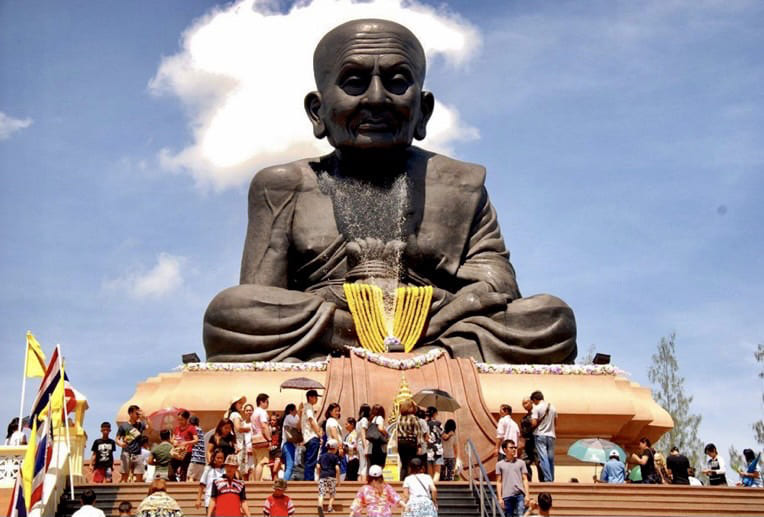
Wat Mahathat Worawihan. A spectacularly tall Buddhist temple, a white tower covered with stucco statues. Enter the temple with many bronze buddhas but not the stupa.
Phuttha Utthayan Makha Bucha Anusorn (Buddhism Memorial Park), Nakhon Nayok. About 1000 Buddha statues including the large walking Buddha
My last day in Thailand. I extended the car rental for a big drive about to see things west and north of Bangkok. Away very early, I drove like a madman. Returned the car – drove 3200 km in 6 days.
Wat Bang Phra. An over-the-top temple with a large black Buddha sitting on a complex plinth. The temple is also known for the daily tattoos given by the monks. The power of any amulet or tattoo decreases with time, so, to re-empower tattoos each year. Arrive around 8:00 AM, purchase flowers and incense that are then recycled back into the place where purchased and the money used for upkeep for the Wat. The tattoos are done in groups of about 20 people choosing from a large banner of tattoos available. Unless there is a specific choice requested, the monk will begin with a simple tattoo at the top of the back. The monk uses a single long thin needle about 18 inches in length and the tip of the spike is split into two so that each stab of the spike produces two dots of ink done on a template to transfer the design. The typical tattoo takes about 3,000 strikes to complete. The sanitation of the needle and ink are unknown. Receiving a tattoo at the Wat Bang Phra temple potentially exposes a person to HIV, Hepatitis B, or Hepatitis C.
Wat Chedi Hoi, Pathum Thani. Original built by a monk resident but the pagoda was built in 1983 using the gigantic oysters aged over thousands of years. It consists of two pagodas. Inside the temple area, there is a large swamp with fish and turtles pond next to it.
Luang Pho U Thong (Phra Phuttha Pusaya Khiri Sri Suvarnabhumi). Luang Pho U Thong, a seated Buddha statue carved on the cliff face of Khao Tham Thiam hill. The sculpture is 84m tall. It was initiated in 2014 to transform a 100 rai quarry, that was full of trash after the site was abandoned, into a pilgrimage site. The aim was to highlight U Thong as the first place the influence of Buddhism reached the Kingdom more than 2,500 years ago.
Great Buddha of Thailand, Ang Thong. A 92m tall sitting Buddha, the tallest statue in Thailand, the second tallest statue in Southeast Asia, and the ninth-tallest in the world. 63 m wide. Construction 1990 – 2008. It is painted gold and made of concrete. The Buddha is in the seated posture called Maravijaya Attitude. The Ubosot (ordination hall) is surrounded by the largest lotus petals in the world, a museum with the first and largest silver holy Buddha image of the country, a compound that has depictions of heaven and hell, a Thai deity paradise, a Chinese deity paradise, and a huge statue of KuanIm, a Chinese female goddess. Located in the Wat Muang temple.
Wat Khun Inthapramun, Pho Thong. A giant white reclining Buddha. Body and legs covered in an gold coloured cloth. Built in the 1830s, the long statue stretches for more than 45 metres. The statue’s feet are particularly attractive; the soles are split into different sections that show various symbols of Buddhism, and they are decorated with mother of pearl. Surrounded by ruins – low brick walls and columns and a brick temple across the street.

Wat Pikul Thong Phra Aram Luang, Phikul Thong. A giant gold sitting Buddha and a small temple across the road. All the lamp posts entering and leaving the town are topped with a gold elephant and a glass globe hanging from his trunk.
Wat Phra Non Chaksri Worawihan, Singburi. In a temple that predates the Ayutthaya Kingdom, it has a large reclining Buddha almost 50 metres long, a gilded stone image, and a seated image in the diamond throne posture. The two sacred images have beautiful features. They were built during the reign of King Rama V.

LOPHURI
Prang Sam Yod, In the NM Vestiges of the past series, this is a 13th-century temple and a popular tourist destination. The temple was built by King Jayavarman VII of the Khmer Empire in the early 13th century. Jayavarman intended for the temple to be an important location in the royal cult surrounding himself, and showcased the prestige of the Khmer Empire in Lopburi. Of Khmer architecture, the temple is made of brick with an absent stucco exterior – three towers, each with a corresponding deity. Originally dedicated to Mahayana Buddhism, it was later rededicated to Theravada Buddhism.
An image of Phra Prang Sam Yod is featured on a Thai baht note. While it remains the site of active prayer, several sources have noted the temple is more popular as a tourist destination due to its resident population of monkeys. The temple is in relatively poor condition.
Monkeys. The temple is famous for its large population of crab-eating macaque monkeys that live in the temple grounds. Monkeys have always been present in Lopburi, but the Monkey Buffet Festival in 1989 led to a dramatic increase. The festival draws tourists while honours the traditional Lopburi belief that monkeys are disciples of Jao Paw Phra Kan, a spirit which protects the city.
There are 2 other archaeological sites in the city – one is a huge pile of laterite blocks. Another is a large complex of several ruined brick temples.
Chao Sam Phraya National Museum. Archaeology from Ayutthaya was discovered in 1957-8 with many Buddhas, ceramics, jewelry and the highlight of several gold artifacts including a golden sword 115 cm long in a golden scabbard. There is a traditional Thai house in the middle of a pond. 100 B
CHINA, Liaoning Northwest
Shenyang Banruo Temple. A small Buddhist temple with 4 gold Buddhas and the usual decorative elements.
Ci’en Temple. Another Buddhist temple but under renovation. I was able to enter the grounds and peer through some windows.
Changan Temple. A large Buddhist temple complex but all gates were closed.
SOUTH KOREA
SEOUL
Bongeunsa Temple. A Buddhist temple that dates back to 794 located south of the Han River. During the Joseon Dynasty, the government oppressed Buddhism and supported Confucianism. Around 1550 Bongeunsa was expanded and became the head monastery of the national Jogye Seon Order. It also was the main Korean Buddhist Zen temple from 1551 to 1936. In 1939, and again during the Korean War (1950-1953), most of the temple buildings were heavily damaged or destroyed by fire.
The highlight of the temple though is a 28-meter stone statue of Maitreya, the Future Buddha. This statue is one of the tallest stone statues in the country. It has a platform with a stupa on its head. The oldest remaining building is a library that was constructed in 1856.
Today, Bongeunsa Temple is pleasant and peaceful. Twice a day, at 4:10 and 18:40, a percussion ceremony using four instruments is performed by the monks of the temple.
SANSA, BUDDHIST MOUNTAIN MONASTERIES in KOREA WHS. The Sansa are Buddhist mountain monasteries located throughout the southern provinces of the Korean Peninsula. The spatial arrangement of the seven temples that comprise the property, established from the 7th to 9th centuries, present common characteristics that are specific to Korea – the ‘madang’ (open courtyard) flanked by four buildings (Buddha Hall, pavilion, lecture hall, and dormitory). These mountain monasteries are sacred places, which have survived as continuous living centres of faith, spiritual practice, and daily religious practice of Korean Seon Buddhism.
They demonstrate self-sufficient temple management, education of monks, and coexistence of meditative practice and doctrinal studies despite suppression during the Joseon Dynasty and damages caused by wars and conflicts over the years.
Sansa consists of seven Buddhist mountain monasteries—Tongdosa, Buseoksa, Bongjeongsa, Beopjusa, Magoksa, Seonamsa and Daeheungsa – diverse Buddhist schools.
Buseoksa is a Buddhist temple located near Mt. Bonghwang, Yeongju City. Founded by the prominent scholar-monk Uisang in 676, Buseoksa is also well known as the “Temple of the Floating Stone”.
The temple’s main hall is the Muryangsujeon located at the highest level where Amitabha is enshrined. It is the second oldest standing wooden building in South Korea, re-constructed in 1376. A few buildings from the Goryeo era (9th century to the late 14th century) remain until now, including Muryangsujeon.
Buseok Temple is located on a steep mountain and the architects built stone walls along the slope and then arranged the buildings accordingly. There are nine stone walls on the temple grounds and nine sets of stairs linked to the stone walls representing the nine stairs toward Mandala or the nine staircases that one must traverse to reach Nirvana.
As the oldest building, the temple cherishes several assets: 5 national treasures.
Muryangsujeon Hall
Stone lantern in front of Muryangsujeon Hall
Josadang Hall of Buseoksa temple
Seated clay statue of Amitabha Buddha
Wall painting in Josadang Hall of Buseoksa temple
My experience. I parked in front of a great waterfall and pond with a fountain display. It is a steep climb up to the temple on many stairs on a hot, humid day. Muryangsujeon Hall has one Buddha image, wonderful beams, rafters, eves, and columns.
HAEINSA TEMPLE JANGGYEONG PANJEON The Depositories for the Tripitaka Koreana Woodblocks. WHS. Mount Gaya is home to the Tripitaka Koreana, the most complete collection of Buddhist texts, laws, and treaties extant, engraved on 80,000 woodblocks between 1237 and 1248. The buildings of Janggyeong Panjeon, which date from the 15th century, were constructed to house the woodblocks, which are also revered as exceptional works of art. As the oldest depository of the Tripitaka, they reveal an astonishing mastery of the invention and implementation of the conservation techniques used to preserve these woodblocks.
They were carved in an appeal to the authority of the Buddha in the defense of Korea against Mongol invasions. They are also valuable for the delicate carvings of the Chinese characters, so regular as to suggest that they are the work of a single hand.
The Janggyeong Panjeon depositories comprise two long and two smaller buildings arranged in a rectangle around a courtyard. Constructed in the 15th century, they were specially designed to provide natural ventilation, modulate temperature and humidity, and prevent rodent and insect infestation
The woodblocks and depositories are of wood construction and are susceptible to fire damage and theft.
There were many monks and nuns in long grey robes.
My experience. It was about 60 km from Daegu to Haeinsa. The last bit was through a lovely mature red pine forest and a great stream full of boulders. Pay the 4000W entry at the road gate. Don’t park at the “small” lot but turn right to the big lot in front of the museum (hours 10-5).
Walk about 1 km up the Nature Interpretive trail (only Korean), and pass several great stelae with capstones, some shops, and steps. The main Buddha hall is wonderfully painted inside. More steps take you up to the woodblock area. Pass through the first building with the best view of the blocks (you can’t enter any of the four buildings). Two small side buildings and another large building full of blocks stacked on the shelves. You can only see the blocks through slats from the outside.
The 81,350 blocks are 70 x 24 x 2.8 cm and weigh 3.25 kg each. There are 23 lines of characters with 14 characters per line on both sides.
The museum just opened as I walked down from above. The most interesting object was a small portable Buddha shrine.
SEOKGURAM GROTTO and BULGUKSA TEMPLE WHS. Established in the 8th century under the Silla Dynasty on the slopes of Mount Toham.
The Temple of Bulguksa(built in 774) is a Buddhist temple complex of wooden buildings on raised stone terraces. It has three areas – Birojeon (the Vairocana Buddha Hall with a seated gilt bronze Buddha), Daeungjeon (the Hall of Great Enlightenment with three very nice relics), and Geungnakjeon (the Hall of Supreme Bliss with a seated gilt bronze Amitaba image). These areas and the stone terraces were designed to represent the land of Buddha. The stone terraces, bridges, and the two pagodas – Seokgatap (Pagoda of Sakyamuni) and Dabotap (Pagoda of Bountiful Treasures – this is a tremendous pagoda with pillars, a cap and a spire) – facing the Daeungjeon attest to the fine masonry work of the Silla.
The Japanese burnt the temple in 1593, and rebuilt and renovated it in 1969-70.
The Grotto is a 7.4 km drive up a winding switchbacked road. Pass through the Anyangmur Gate on the way.
Seokguram Grotto contains a monumental statue of the Buddha looking at the sea in the bhumisparsha mudra position (left hand in dhyana mudra, the mudra of concentration, and his right hand in bhumisparsa mudra, the earth-touching mudra position). With the surrounding portrayals of gods, Bodhisattvas, the Ten Disciples, Eight Divine Guardians, two Devas, and two Vajrapanis all carved realistically and delicately from white granite in high and low relief, it is considered a masterpiece of Buddhist art in the Far East. The domed ceiling of the rotunda and the entrance corridor employed an innovative construction technique that involved the use of more than 360 stone slabs.
This is not quite what I imagined. There were seats for about 40 in the entrance area covered with a wood pavilion. The walls had the 8 guardians and two other images. The rotunda is quite small with the stone Buddha in the center. A priest was chanting in front of it.
YANGSAN
Tongdosa is a head temple of the Jogye Order of Korean Buddhism and one of the Three Jewels Temples and represents Gautama Buddha. (Haeinsa, represents the dharma or Buddhist teachings; and Songgwangsa represents the sangha or Buddhist community.)
Tongdosa is Korea’s largest temple and is famous because there are no statues outside of the Buddha at the temple because the “real shrines of the Buddha” (relics) are preserved at Tongdosa. Courtyards at the temple are arrayed around several pagodas that house the Buddha’s relics. Instead, a Buddhist altar spans the front with a window, in the place of a Buddha image.
Tongdosa was established in 646 AD, thrived throughout the Later Silla and Goryeo periods (918-1392), when Buddhism was the state religion, and remained strong even during Joseon.
Tongdosa is reputed to house several relics of the Buddha himself, including a robe, a begging bowl, and a bone from his skull, all relics that Jajang-yulsa brought back from his travels to Tang China.
Only one building, the Mahavira Hall (main Dharma worship hall), survived the Japanese invasions of Korea (1592–98). In the mid-15th century at the height of its prosperity, Tongdosa is said to have had hundreds of buildings and thousands of monks. For over 1,300 years Tongdosa’s Beopdeung (temple candle) has never gone out.
65 buildings separately house a shrine for virtually every major Buddhist deity. Many of the buildings are dispersed throughout the surrounding mountainside. There are 13 hermitages. The buildings are varied in architectural style with many left unpainted or faded.
A museum on the temple grounds displays an excellent collection of artwork. Today at this temple there are 19 local treasures and 794 local cultural properties.
The Samseongbanwol — Three Arch Bridge crosses the river to the temple.
Pass through three gates: Iljumun (One-Pillar Gate), the Gate of the Guardians of the Four Directions, Purimun (Gate of Non-Duality).
The Buddha’s relics are in the Diamond Altar, a platform for the ceremony prevailing Buddhist precepts, behind Daeungjeon (main Dharma Hall).
Walk along a lovely river for about 600 m, cross the bridge, and enter the temple
AFGHANISTAN
Bamiyan Buddhas. Destroyed by the Taliban in 2001. 
